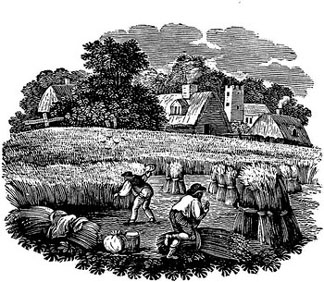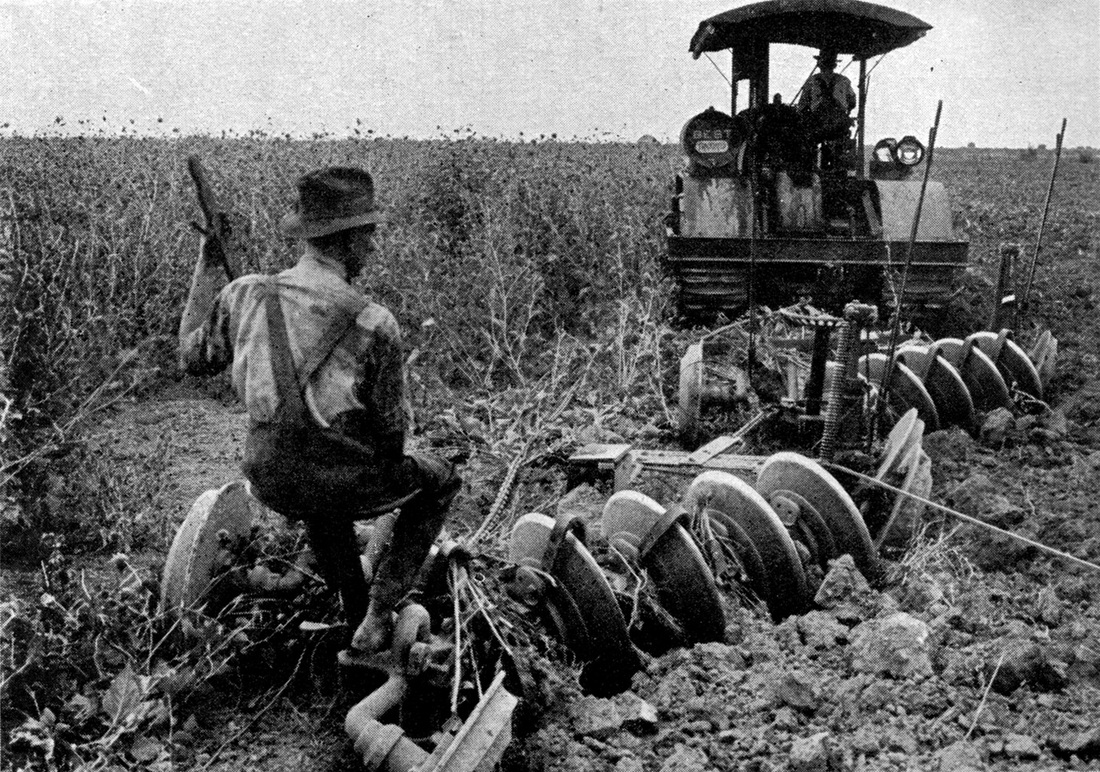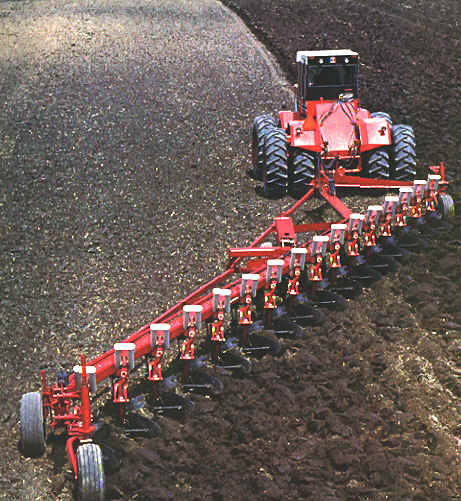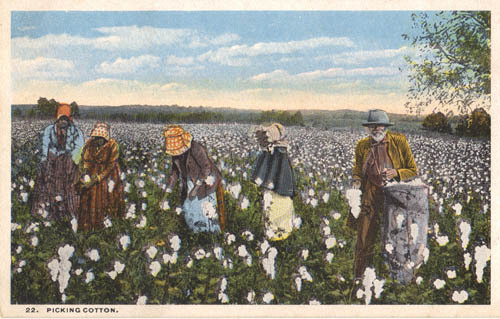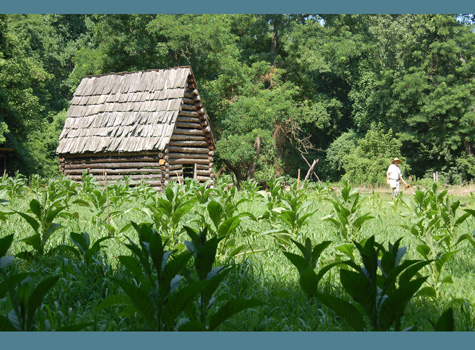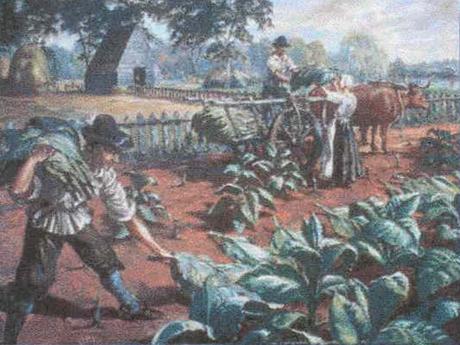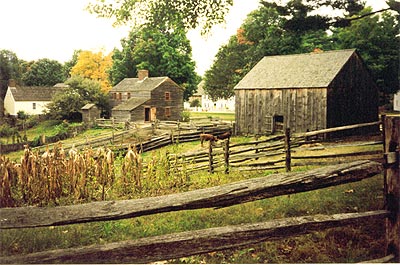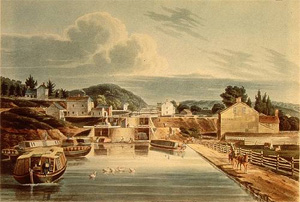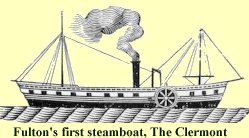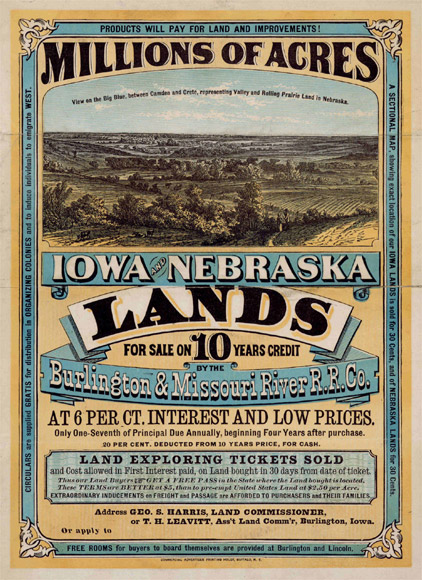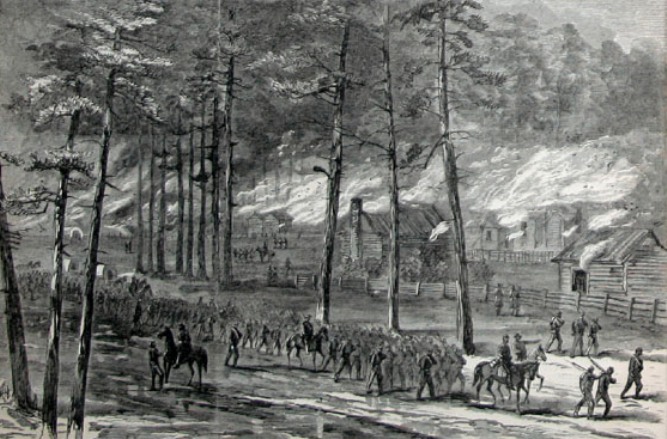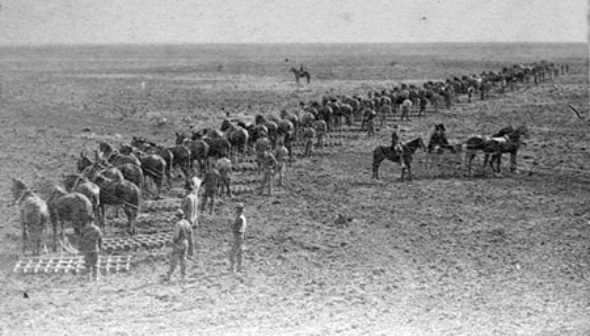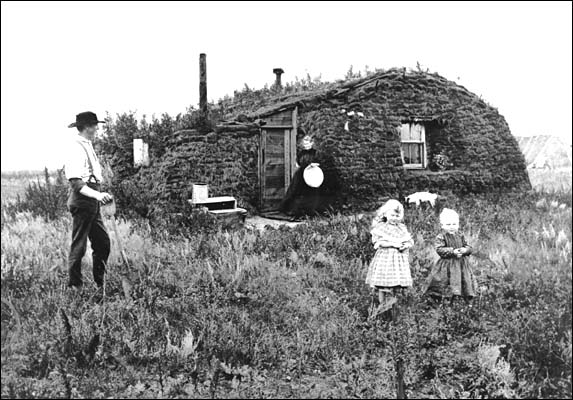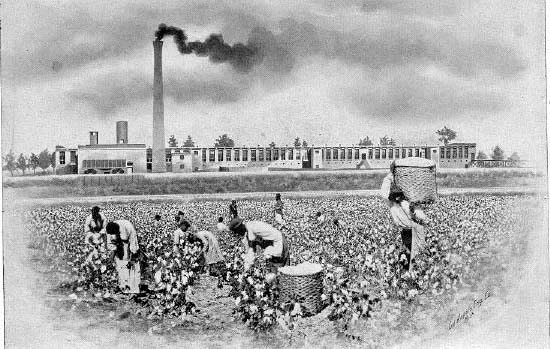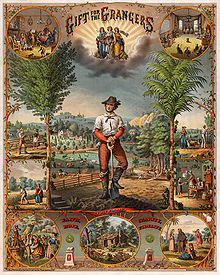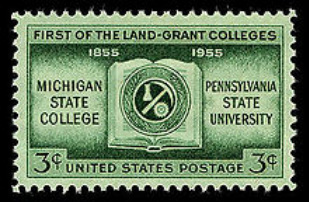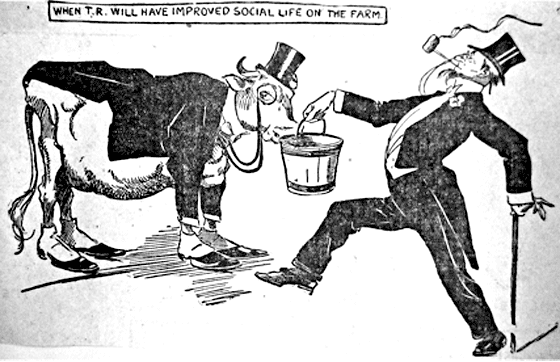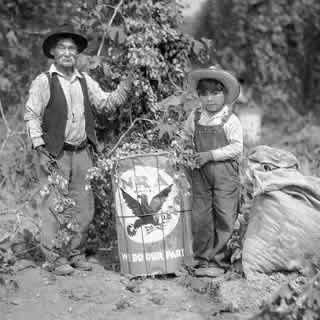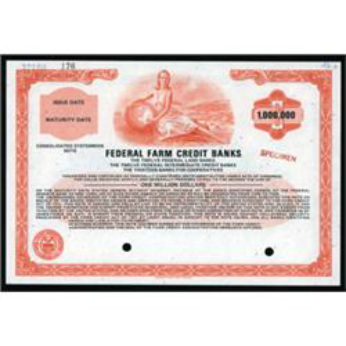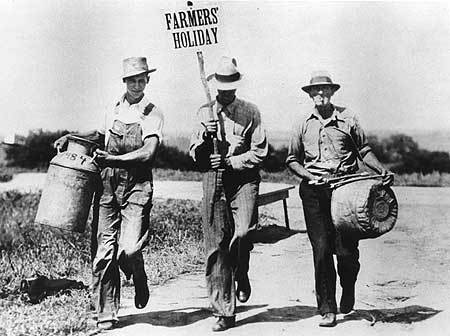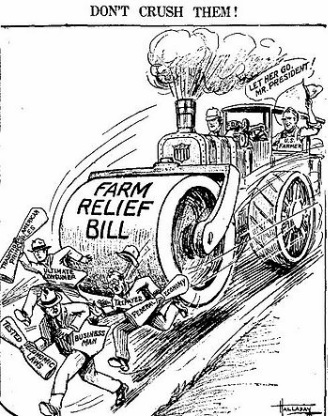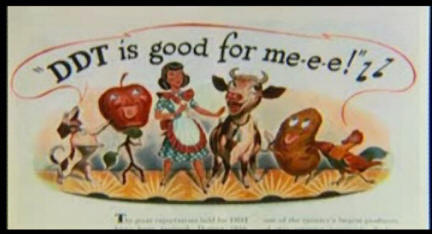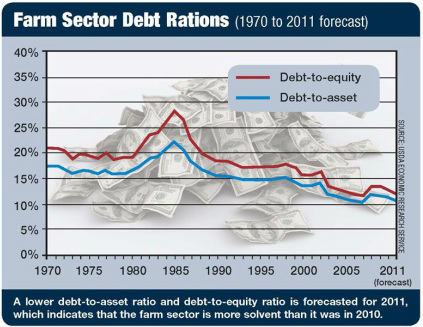Our Farming Heritage and the Politics of the American Farm
George Santayana's famous (and often corrupted) quote states," Those who cannot remember the past are condemned to repeat it."
Within the intent of this quote lies the truth that knowledge of the past leads to a greater ability to live in harmony in the present and plan for
the future. Knowing and understanding the roots of agriculture is an integral component of the holistic approach to farming. Farming (and agriculture in
general), in a technical sense, can trace its roots back to prehistoric times, achieving a respectable degree of scientifically-based sophistication by the
early 16th century.
In the United States, prior to the Revolutionary War, farming began to transcend the actual physical acts of animal husbandry
and planting, becoming woven into the very fabric of the nation itself and influencing all aspects of the society, from politics to social issues.The Erie Canal was completed in 1825, providing a supply line west and a valuable water-link to the east coast for agriculturual commodities produced in the West. In the decades preceding the Civil War the influences of the Lyceum Movement opened the rural community to new ideas, new science and new technology, which in turn led to a better understanding of farming as a business and farming as a science. In the decades spanning 1840-1860 railroads expanded their tracks by ten times, allowing farmers in landlocked locations transportation access.
By the end of the Civil War, sophisticated and integrated transportation infrastructures where in place. Labor supplied by a great influx of willing and able immigrants ( a number of them being Old-World farmers) provided the manpower to meet the demand of the agriculturual sector. New technology and technological research fueled greater production. The importance of farming was finally recognized by the establishment of the Department of Agriculture in1862. The Morrill Land Grant College Law was passed in 1862 and land supplied by the Homestead Act, land speculators and the railroads created almost limitless opportunities for new farmers. American agriculture, in a plethora of forms, was established from coast to coast by the end of the 1860’s. Even as the Southern plantation system faded into obscurity, more than half of all Americans derived their income directly from farming. Farm
products accounted for 79% of all export revenue.
In the first decade of the 20th century, farming was still the largest single sector of employment in the United States. Farming, as an industry, accounted for 58% of all exports ($917 million or $23 billion in today’s dollars) and over 30% of the population
engaged in farming. (1)(2)(3)(4)
A Brief Lesson: Agriculture Since the Dawn of Man to the Present , the World View. ( click screen to play)
History Of Agriculture from Farmsphere.com on Vimeo.
PART ONE : The Dawn of a New Country and the Engine of Agriculture.
The importance of agriculture during this period can be appreciated simply by looking at two numbers: farm population as a percent of the work force, and percent of total exports /dollar value. As illustrated below, though the number of farmers decreased over the span due to a shift from rural to urban-based economies, the dollar value of agricultural exports increased exponentially over the same period. Furthermore, it is important to emphasize that despite the shifting economy during this period, more than one out of every two Americans farmed (until 1880) and many more performed
the ancillary services such as the processing, transportation, and the commerce associated with farm-produced products.
The importance of agriculture during this period can be appreciated simply by looking at two numbers: farm population as a percent of the work force, and percent of total exports /dollar value. As illustrated below, though the number of farmers decreased over the span due to a shift from rural to urban-based economies, the dollar value of agricultural exports increased exponentially over the same period. Furthermore, it is important to emphasize that despite the shifting economy during this period, more than one out of every two Americans farmed (until 1880) and many more performed
the ancillary services such as the processing, transportation, and the commerce associated with farm-produced products.
Overview and Growth of Farm Production 1790-1900
Date Farm population as a % of workforce. % of all exports / value per annum
1790 90% 44% / $4.36 million (tobacco major export)
1810 n/a 75% / $23 million
1819 n/a 87%/$40 million
1829 n/a 65%/$42 million
1839 n/a 69% / 73%/$74 million
1849 n/a 65%/$90 million
1859 58% 81%/$189 million
CIVIL WAR PERIOD
1870 53% 79%/$453 million
1880 49% 76%/$574 million
1890 43% 71%/$703 million
1900 43% 71%/$703 million
(5)(6)
Date Farm population as a % of workforce. % of all exports / value per annum
1790 90% 44% / $4.36 million (tobacco major export)
1810 n/a 75% / $23 million
1819 n/a 87%/$40 million
1829 n/a 65%/$42 million
1839 n/a 69% / 73%/$74 million
1849 n/a 65%/$90 million
1859 58% 81%/$189 million
CIVIL WAR PERIOD
1870 53% 79%/$453 million
1880 49% 76%/$574 million
1890 43% 71%/$703 million
1900 43% 71%/$703 million
(5)(6)
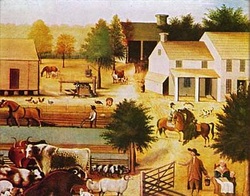
A Brief but Important Review of Milestones, Sucesses and Failures Prior to and During the First Millenium of American Agriculture.
As the commodification of American agriculture evolved, its complexity, its functions and its role in society transcended its core purpose of providing food and clothing. New sciences were developed to improve the processes and production. Agriculture was used as a tool by the powerful to tame frontiers. It was employed by speculators to lure the naïve, the adventurer, and hopeless into visions of a bright future. It gave the young nation economic clout throughout the world and it was an inexhaustible source of revenue for colonial, local, federal and state governments and the bureaucracies set up to regulate it.
As the commodification of American agriculture evolved, its complexity, its functions and its role in society transcended its core purpose of providing food and clothing. New sciences were developed to improve the processes and production. Agriculture was used as a tool by the powerful to tame frontiers. It was employed by speculators to lure the naïve, the adventurer, and hopeless into visions of a bright future. It gave the young nation economic clout throughout the world and it was an inexhaustible source of revenue for colonial, local, federal and state governments and the bureaucracies set up to regulate it.
|
The Colonial Period
In the New England colonies, after a brief era of communal farming, the colonists employed family units to grow and maintain the small subsistence farms that produced the surpluses which became the basis for one of the very dominant models of American agriculture. In the mid- Atlantic and Southern areas, along with the small family farm model, larger farms built through political connections, grants and deceitful land deals began to emerge. Utilizing skills taught to them by Native Americans, these farms, loosely based on the estate/plantation models of imperial England, concentrated mainly on the labor intensive growing of tobacco (adding cotton later) as a cash crop, while growing corn as a food and feed source. While originally employing indentured whites and occasionally Native American labor, the plantation/estate labor was supplanted almost entirely by slaves brought from Africa beginning in 1680. As the South concentrated on labor intensive non-food crops (with the exception of growing corn and rice), the Northern farms produced everything from tobacco to fruit to grain and root crops, adding livestock at the turn of the century (1700). During this period it appears that the Northern farms had a market advantage because of their diversity and their ability to tap into both domestic and export markets, while the South was heavily reliant on England and the export market. It is important to understand that when taking a long look at the underpinnings of American agriculture and its rise, its connection to the spectrum of markets from local to world, is of extreme significance economically, socially and politically. This very unique characteristic of American agriculture is what set it apart from previously practiced systems. This foundation, which was established and evolved during this Colonial period, became entrenched until the Civil War period, when the systems finally clashed and the differences and problems inherent in each came to a head. (7) (8) |
|
Important Milestones 1776-1803 · The invention of the cotton gin in1793 The invention of the cradle and scythe system for grain harvesting.: circa 1795. The invention of the Newberg and Peacock plows followed by the Jethro Wood model. 1797-1814 (approx.) · Improved transportation infrastructure, notably the Lancaster Turnpike – 1794. · The establishment of the agricultural organizations and societies such as The Philadelphia Society for the Promotion of Agriculture Field Husbandry-1785 · The Louisiana Purchase opened new land and gave clear access to the Mississippi River and Gulf of Mexico – 1803. (4)(5)(6)(9)(11) American Agriculture 1803-1824
For the first part of the decade (1800-1807) agriculture boomed as westward expansion became more practical due to improved roads, water access (Great Lakes/Ohio and Mississippi rivers) and canal systems. North-Eastern agriculture continued to grow in correlation to burgeoning urban growth as the mid-Atlantic region and the upper South continued to grow tobacco and corn, and became the main foodstuff supplier for the Deep South, which was so consumed with cotton production that it could not supply its own food. With 75% of all exports now derived from agriculture and more than 80% of the population employed by farms or the farm related industries, the nation went into economic shock when Thomas Jefferson introduced the Embargo Act of 1807 and the subsequent Non-Intercourse Act of 1809. Both controversial acts were designed to address a number of mainly maritime problems the U.S. had been experiencing as a consequence of trading with Britain and France as these countries engaged in yet another power struggle for control of Europe. By virtually eliminating trade with these two chief importers of American goods (overwhelmingly agricultural in nature) Jefferson created a whole new set of problems for farmers and the populace in general. These acts (Embargo Act of 1807 and Non-Intercourse Act of 1809) were repealed, but by then, the British and other former importers of U.S. farm products discovered alternative sources, specifically in South America. (4)(5)(6)(9)(11) |
The Revolution to the Turn of the Century
The immediate post-Revolutionary War period temporarily plunged the agriculture market and the expansion of agriculture into a period of uncertainty and chaos, Gradually, after 1783, trade-alliances began to re-form and westward expansion moved forward.The invention of the cotton gin in1793 changed the complete complexion of Southern agriculture. In the North, agriculture continued its ponderous metamorphosis from the subsistence/surplus model to a commodification model. Historical economist Robert Sherry characterizes this conversion process as a shift to a “commodity-money-commodity” cycle in which the entire production of the farm was saleable. As the West opened, this conversion continually repeated itself: frontier settlers farmed for subsistence first, then became established, producing small surpluses, then expanded and created large commodity surpluses for sale.At the turn of the century (1800) virtually every leader of the nation was still a farmer or had agrarian roots; as such, men like Jefferson and Washington had both a personal and business stake in the direction agriculture would take. Moving forward into the new century farmers began to lose their independence and started to became both dependent and resentful of the role government played in their everyday dealings. After 1783, all unsettled land came under the authority of the federal government. Ironically, plantation owner Thomas Jefferson was an advocate for the small, independent/family farm model and it was legislation written by him in 1785 (Ordinance of 1785 and follow-up Northwest Ordinance of 1787) that was truly the first significant example of how the government could directly influence the direction of farming in the United States and simultaneously raise revenue. It was this legislation that set federal land policy precedent and remained viable until the passage of the Homestead Act of 1863. With the acceptance of a money-based system, farmers ceded more of their independence over to governmental entities and as such, found themselves at greater mercy to the whims of these entities. According to National Archives records, literally tens of millions acres of government land (unsubstantiated sources put the number as high as 70 million acres), ranging from 100 to 1100 acres, some assignable, were granted to veterans of both the Continental Army and the War of 1812 through 1858 much of which was eventually converted to farmland. (9)(10)(11)(12)(13)(14) While the government continued to use agriculture as a pawn
through the War of 1812, new inventions and ideas about farming began to emerge. Transportation of goods improved greatly. Though short lived, thousands of miles of “farmer’s” or plank roads built specifically for the movement of heavy freight were built. The canal building movement began in earnest and planning for the Erie Canal was underway. Shortly after Robert Fulton launched his steamboat, the Claremont in 1807, newer versions designed specifically for carrying freight were developed and put to use from the Atlantic to the Mississippi, greatly enhancing the movement of farm commodities and expanding markets exponentially. Specialization continued in the North, and in the newly opened mid-West a movement toward creating a corn and grain belt began. At first mainly a novelty, the canning industry offered farmers an outlet for their goods, with the first commercial operation established in 1812. From government agencies to private advocacy groups, farming began to be looked at as an organized and integrated entity: in 1810 the Agricultural Museum magazine was published, followed by the American Farmer and Plough Boy in 1819. New York State established the New York Board of Agriculture in 1819, and in 1820 and 1825 respectively, the House of Representatives and the Senate establish federal Agriculture Committees. Following a brief economic downturn that reached its peak in 1819, American agriculture regained an a era of prosperity driven again by new technologies, new trade policies, and further advances in technology and education. Following the general trend in the country towards greater education of the masses, i.e.: public schools, the Lyceum Movement, the rural community was opened to new ideas, new science and new technology which in turn led to a better understanding of farming as a business and farming as a science. Men such Edmund Ruffin, the father of American agronomy (An Essay on Calcareous Manures), moved agriculture radically and rapidly forward by helping farmers make a scientific connection between what they did culturally on the land and how it affected the land over time. To many agricultural historians and economists, this time in history represented an era when the true commercialization of farming was realized.(15)(16)(17)(18) |
1825-1860 Agricultural Ups, Downs, and the Impending Conflict of the Civil War.
The Erie Canal was completed in 1825, providing a supply line west and a valuable water-link to the east coast for commodities produced in the West. The 1820 Land Act, over the course of the next two decades, enabled many more citizens to become landowners, in fact more than doubling the sale of public lands over the previous twenty years (1800-29:16 million acres. 1821-1841:75 million acres). Additionally, preemption laws were passed and revised continuously during this period (1820-41), giving
squatters various degrees of rights to the land they settled on and worked. Historian David Danbom illustrates the rise and links formed between the country’s growing industrial center and agriculture, citing as an example the story of Proctor and Gamble, who moved their operations to Cincinnati, the “swine capital of the west,” to be close to a reliable supply of lard for soap and candle making. He further illustrates this symbiosis by pointing to the fact that off-season farm labor increasingly found a place in the industrial centers, providing labor for the processing of agricultural commodities as well as supplemental income for the farm family. As farming aided industry, industry provided for the farmer in the form of new technology: within the span of three years, McCormick introduced the mechanical reaper, John Deere, the steel plow, and Avery and Pitts their improved threshing machine.
In 1830, Andrew Jackson culminated a personal campaign, that spanned over 20 years, against the “Five Civilized Tribes” of the Southeast with the passage of the Indian Removal Act of 1830.23 This law forcefully (see “Trail of Tears”) ended all legal claims native American tribes had on land that was coveted by Southern plantation owners and settler farmers. In a larger sense this event served to relegate the role the indigenous people played in early American agriculture to relative insignificance. The farming methods and crops that allowed the early settlers to survive came from a hybridized adaptation of Native American agriculture; and with the exception of a minor mention around Thanksgiving, there is but minor recognition of that fact.
In 1841 the second Preemption Act was passed opening up additional public lands for settlement at a relatively modest price of $1.25/acre for squatters who had lived on a plot of up to 160 acres. In the decades spanning 1840-1860 railroads expanded their tracks by ten times, allowing farmers in landlocked locations transportation access. As expansion continued, the specter of the one -free/one- slave state, Missouri Compromise of 1820 loomed in the background as political and economic tensions between Southern and Northern farmers continued to build. Beyond all moral and philosophical considerations, there were high-stakes economic issues in play, including a perception by those in the north that the slave trade gave the Southern states an unfair competitive advantage in agricultural production and processing. Additionally, the aforementioned dealings with the farming Indian tribes of the South by Southerners, including illegal land grabs, offended the Northerners and flew in the face of those on the federal level that promoted farming by Native Americans as a peaceful and humane method to handle the “Indian problem”and a path to assimilation. In a fashion, the North was able to counter the advantages of
slave labor, and at the same time continue the supply of free-white farmers for expansionism by promoting and sanctioning liberal immigration policies that favored Northern Europeans. Fueled by the Irish Potato Famine of 1845 and economic problems throughout Europe, immigration to the U.S. increased
by almost 600% in the period between 1841 and 1860 (4,311,465) with 87% of this population coming from Ireland, Germany, and Great Britain. Though
many of these immigrants came as a result of problems at home, many also came because of the lure of land ownership and farming on the new frontier
accompanied by incentives coming from railroads, the largest private sector land owners. (19)(20)(21)(22)(23)(24)
The Erie Canal was completed in 1825, providing a supply line west and a valuable water-link to the east coast for commodities produced in the West. The 1820 Land Act, over the course of the next two decades, enabled many more citizens to become landowners, in fact more than doubling the sale of public lands over the previous twenty years (1800-29:16 million acres. 1821-1841:75 million acres). Additionally, preemption laws were passed and revised continuously during this period (1820-41), giving
squatters various degrees of rights to the land they settled on and worked. Historian David Danbom illustrates the rise and links formed between the country’s growing industrial center and agriculture, citing as an example the story of Proctor and Gamble, who moved their operations to Cincinnati, the “swine capital of the west,” to be close to a reliable supply of lard for soap and candle making. He further illustrates this symbiosis by pointing to the fact that off-season farm labor increasingly found a place in the industrial centers, providing labor for the processing of agricultural commodities as well as supplemental income for the farm family. As farming aided industry, industry provided for the farmer in the form of new technology: within the span of three years, McCormick introduced the mechanical reaper, John Deere, the steel plow, and Avery and Pitts their improved threshing machine.
In 1830, Andrew Jackson culminated a personal campaign, that spanned over 20 years, against the “Five Civilized Tribes” of the Southeast with the passage of the Indian Removal Act of 1830.23 This law forcefully (see “Trail of Tears”) ended all legal claims native American tribes had on land that was coveted by Southern plantation owners and settler farmers. In a larger sense this event served to relegate the role the indigenous people played in early American agriculture to relative insignificance. The farming methods and crops that allowed the early settlers to survive came from a hybridized adaptation of Native American agriculture; and with the exception of a minor mention around Thanksgiving, there is but minor recognition of that fact.
In 1841 the second Preemption Act was passed opening up additional public lands for settlement at a relatively modest price of $1.25/acre for squatters who had lived on a plot of up to 160 acres. In the decades spanning 1840-1860 railroads expanded their tracks by ten times, allowing farmers in landlocked locations transportation access. As expansion continued, the specter of the one -free/one- slave state, Missouri Compromise of 1820 loomed in the background as political and economic tensions between Southern and Northern farmers continued to build. Beyond all moral and philosophical considerations, there were high-stakes economic issues in play, including a perception by those in the north that the slave trade gave the Southern states an unfair competitive advantage in agricultural production and processing. Additionally, the aforementioned dealings with the farming Indian tribes of the South by Southerners, including illegal land grabs, offended the Northerners and flew in the face of those on the federal level that promoted farming by Native Americans as a peaceful and humane method to handle the “Indian problem”and a path to assimilation. In a fashion, the North was able to counter the advantages of
slave labor, and at the same time continue the supply of free-white farmers for expansionism by promoting and sanctioning liberal immigration policies that favored Northern Europeans. Fueled by the Irish Potato Famine of 1845 and economic problems throughout Europe, immigration to the U.S. increased
by almost 600% in the period between 1841 and 1860 (4,311,465) with 87% of this population coming from Ireland, Germany, and Great Britain. Though
many of these immigrants came as a result of problems at home, many also came because of the lure of land ownership and farming on the new frontier
accompanied by incentives coming from railroads, the largest private sector land owners. (19)(20)(21)(22)(23)(24)
|
1860-1870. The War and Aftermath.
The federal government also created new incentives with the passage of the Homestead Act of 1862 which made public land available to immigrants.With the Civil War in full motion and slavery no longer a consideration, the government was now able to open the estimated 1.5 billion acres of public land, in 160 acre parcels, to any one who was willing to register, homestead for five years, and pay a minimal fee. Because the land was transferable to one’s heirs, the incentive was even greater, and over the course of time, the Homestead Act succeeded in creating the foundation for a new class of family farmers in the west and the beginnings of a Western middle-class. Important milestones of the decade: 1) a sophisticated and integrated transportation infrastructure in place 2)the influx of willing and able immigrants ( a number of them being Old-World farmers) 3) new technology and technological research ongoing ( the Department of Agriculture was finally established in 1862 and the Morrill Land Grant College Law was passed) 4) land supplied by the Homestead Act 5) land speculators and the railroads promoting and profiting on western expansion American agriculture, in a plethora of forms, was established from coast to coast by the end of the 1860’s. Many areas began to differentiate according to location, environmental conditions, markets and core demographics. The North in response to the growth of great urban centers and the war itself, grew a wide diversity of fruit, vegetables, some corn and grain, and produced the preponderance of the poultry and dairy products in the country; and the family- farm model there, became more efficient and technologically oriented. In the Ohio, the Mid-West, and upper Mid-West, corn and livestock, in particular the pork industry, began to dominate, as the beginnings of the corn-belt were being established. California and the Northwest, with it Pacific Ocean influenced mild climate, mimicked the Northeast in its diverse approach to agriculture (though generally, the farm acreage was greater).(24)(25) |
1865-1870 The Devastation of Southern Agriculture and the Rise of the Great Plains
.After the Civil War and the abolition of slavery, Southern agriculture was left with no foreign markets, an inability to feed itself, no infrastructure to transport goods, and a now-free and landless, former slave population estimated to be over 4 million strong. The capital loss to the South as a result of emancipation was $1.5 billion or put into perspective, twenty times the 1860 federal budget. The federal government was woefully ill-equipped and unprepared to deal with the problems of the post-war South and the demands of an itinerant and largely uneducated population. The Southern Homestead Act (“forty acres and a mule”) of 1866 was a weak and incomplete effort by the federal government to provide former slaves with a start, but with no capital or credit available to the former slaves, and no real administrative infrastructure behind it, there was little chance that this act was anything more than a symbolic effort that served to muddy an already chaotic situation. Large landowners still owned the majority of land in 1870 but there was no system in place to provide labor and as a result, the landowners first tried to set up a contract labor situation with former slaves. This system with its delayed payments and gang-labor structure looked and acted much like slavery, and like the Southern Homestead Act, was doomed to failure almost as soon as it started. The compromise came with the establishment of the sharecropper system, in which land rented from the plantation owner was worked on shares with a percentage of the crop going back to the landowner. Though sharecropping was fraught with inequities and disincentives, it was a stop-gap measure that at least provided some breathing room for Southern agriculture as it began to adapt and reestablish itself after the War. As the century ground forward, new ideas and hybrid-sharecropping adaptations came into being as the South struggled to regain a semblance of its former agriculture industry. In the Great Plains area that spanned from of Texas to the Dakotas, much of the agricultural industry revolved around the production of beef and to a lesser extent, sheep. The grasslands of the region initially provided a free and seemingly limitless supply of feed for raising beef cattle and sheep for wool. Crop farming was limited to the production of feed for horses. In the short span of its heyday, which lasted 20-30 years, prairie cattle-ranching expanded from the southern to the northern plains rapidly with its epicenter in Kansas. Eventually, drought, over-grazing,overproduction, and pressure from the railroads and the expansion of farming enhanced by favorable federal legislation reduced the industry. Ironically, one of the “new” farming technology models: the factory or Bonanza farm, that supplanted open-range grazing in the Plains also provided elements of agricultural management that led to the more manageable feedlot system; a system that all but replaced traditional cattle ranching. This Bonanza-farm model begun in the Northern plains, though short-lived and relegated to just a footnote in most historical accounts of the era, served to become a harbinger of one direction American agriculture took, and provided management models that have been hybridized and applied throughout the entire industry, and as such, Bonanza farming deserves a serious mention.(26) |
The Era of the Bonanza Farm: How Human Arrogance Led To Failure
The long term success of farming and specifically farming as a commercially viable enterprise requires that its practitioners recognize and maintain a unique relationship with, and awareness of, the environment. Those enterprises that have ignored this most basic caveat have ultimately ended in failure. In the history of American agriculture, the Bonanza farm model which began in the 1870’s, and peaked within 10 years of its inception (fading to insignificance by the early 1900’s), provides a textbook lesson of how human arrogance in defiance of nature led to failure on a grand scale.The Bonanza farm came largely into being as an end-result of conditions
facilitated by numerous government acts and actions primarily during and immediately after the Civil War.Though the door was opened by the Preemption Act of 1841, the real business of land speculation did not begin in earnest until the passage of the Homestead Act of 1862. Clever land speculators could engage the services of “dummy entrymen” who could amass tracts of up to 1200 acres, meet legal requirements for ownership and then, in turn, resell these properties to speculators and railroads. Additionally, between 1862 and 1871, Congress granted over 127,628,000 acres to various railroads to encourage them to extend their lines into the new territories of the west. With these large tracts of land in hand, railroads themselves entered the real estate business using this virtually free land as a source of capital to not only expand but to cover shortfalls in their own revenue stream. By selling the land to speculators and at the same time encouraging large scale farming, the railroads gained a double advantage as they held a monopoly on the land closest to rail lines and the exclusive means to move product produced on the farms to a mass market. The most famous and the first pure example of the Bonanza farm was the Dalrymple farm, begun by the Northern Pacific Railroad in 1871. Located in the Red River Valley along the Minnesota-Dakota Territory border and managed by Oliver Dalrymple, this 1280 acre farm (later expanded) produced thirty-two thousand bushels of wheat during its first year of operation, an unprecedented 25 bushels per acre (respectable even by today’s standards). The initial success of the Dalrymple farm spurred on the Bonanza farm movement eventually leading to the creation of mega-enterprises that ranged on the average of 3-30k acres with the largest, the John Miller Company farm, owning
and operating 59k acres. Because of the cheap and abundant capital provided by the railroad, land consortiums and speculators, these farms were seemingly at a great advantage over their conventional farm model counterparts, specifically the family farm/homesteader. The Bonanza operations were able to utilize the latest technological, innovations such as steam engines and threshing machines, and the latest in horticultural advances, including improved strains of spring wheat hybridized to
the semi-arid and often harsh environment of the Great Plains. With these advantages, the Bonanza model experienced a brief period of prosperity that spanned the 1870’s-80’s and spawned others to follow suit. By the late 1880’s, flaws within the Bonanza farm model, such as overproduction, reliance on a monoculture, skill
specialization and high outside labor demands, in terms of sheer numbers in the related labor costs began to emerge. These flaws combined with outside forces
including weather, foreign competition, high taxes and a plethora of social, political and economic changes bought about the rapid demise of this “darling” of new agriculture in less than a generation. According to Kenneth Sylvester author of The Limits of Rural Capitalism,most of the original Bonanza enterprises were subdivided and sold to smaller farmers by the mid-1890. Ownership of the Bonanza farms consisted mainly of absentee investors and speculators who
never set foot on the land themselves and hired professional managers to operate the farms. Though the availability of ready and cheap cash provided by these
investors proved a short term advantage to the Bonanza operation, the lack of a physical connection to the land proved a long term disadvantage. With profit
the overriding factor, the onus of responsible stewardship of the land was all but absent, putting the managers in the position of having the primary function of providing a consistently favorable return on investment above all else. The typical farm was broken down into units ranging in size from 3-5k acres, with a
separate manager responsible for each unit and with each unit broken down into 1200 acre stations managed by a foreman. Work crews, by any standard were
massive and specialized. The aforementioned Oliver Dalrymple operation, in its heyday, employed a harvesting crew of over a 1000 men, operating 30 separate
threshing crews. Accounts of the period found in scholarly journals, specifically those that delve into the economic aspects of the Bonanza farm model, agree that the management of such large workforces with their accompanying problems and inefficiencies occupied an inordinate amount of the management time. Additionally, manager compensation was tied to yields, relegating any beneficial, and long- term cultural practices as secondary considerations. Ultimately this management style
and the seemingly inexhaustible supply of land led to a “slash and burn” attitude (despite the technology and sophisticated agronomics of the time) which
filtered down to the workforce itself. With timing being the most critical factor in both the sowing and harvesting of a crop, particularly on the scale of the Bonanza farms, a large and dichotomous workforce had to be recruited. On one end of the workforce was the unskilled component that provided the hand labor for the farm. Because the typical Bonanza operation would seasonally utilize up to one-thousand or more hands, migrant labor was a necessity. Hiram Drache in his book, The Day of the Bonanza: the History of Bonanza Farming in the Red River Valley of the North, states that as the number of Bonanza farms began to increase the demand for migrant labor increased to the point that it exceeded the supply, which consequently increased the price of migrant labor; two noteworthy conditions that put the Bonanzas at a competitive disadvantage when compared to the relatively self-contained family/homestead operation. On the other end of the labor spectrum was the specialized labor that included working foremen, steam tractor engineers, ploughmen and experienced farmers. Again, the finite supply of labor that possessed the skill-sets required, coupled with the cost of such labor, put the Bonanza operation at a disadvantage that was only exacerbated when environmental conditions and market forces caused price fluctuations that impacted not only the net profit but also caused severe cash flow problems . Without the diversity of crops and animals found in the smaller family-farm models, the wheat monoculture practiced on the majority of the Bonanzas made them unable to “ride-out” both natural and man-made tough times. When environmental conditions were conducive to wheat growing, they could flourish, providing that the market was able to absorb their crop. When yields were down due to drought, insect or disease problems, the Bonanza had no contingency or backup crop to mitigate the losses. At the onset of the Bonanza farm, Europe was still in the
middle of a population increase (estimated to have doubled within the span of a century) that exceeded its own ability to feed itself, a condition that created an ideal market for Red River Valley wheat. By 1895, European agriculture had advanced to the point that it became self-sufficient, driving wheat prices down and creating surpluses in America. As the surplus grew, the price of wheat declined from a high of $1.05 per bushel between 1870 and 1880 to a thirty-year low of $.653 in the 1890’s. Though the Bonanza farm movement managed to hang on into the new century, in the end it was both a victim of its own success and a harbinger of the direction agriculture would eventually take through the new century and beyond. It would be irresponsible not to recognize the technological, managerial and scientific knowledge that were an important and positive contribution to American agriculture. As agriculture entered a new phase, the specialization concept that was born out of this era, particularly in the livestock industry, has become an integral part of modern agriculture. Bonanza farming illustrated that the corporate farm model was not
equipped to deal with the great environmental challenges that arise when attempting to establish a monoculture of a seasonable crop on fragile land. In
this way, it validated the diversified family-farm model that could adapt and offer creative and cooperative solutions to “nature’s curveballs” and at the same time has shown there is no one system that is universally adaptable to the very diverse science of farming. (27)(28)(29)(30)(31)(32)(33)(34)
The long term success of farming and specifically farming as a commercially viable enterprise requires that its practitioners recognize and maintain a unique relationship with, and awareness of, the environment. Those enterprises that have ignored this most basic caveat have ultimately ended in failure. In the history of American agriculture, the Bonanza farm model which began in the 1870’s, and peaked within 10 years of its inception (fading to insignificance by the early 1900’s), provides a textbook lesson of how human arrogance in defiance of nature led to failure on a grand scale.The Bonanza farm came largely into being as an end-result of conditions
facilitated by numerous government acts and actions primarily during and immediately after the Civil War.Though the door was opened by the Preemption Act of 1841, the real business of land speculation did not begin in earnest until the passage of the Homestead Act of 1862. Clever land speculators could engage the services of “dummy entrymen” who could amass tracts of up to 1200 acres, meet legal requirements for ownership and then, in turn, resell these properties to speculators and railroads. Additionally, between 1862 and 1871, Congress granted over 127,628,000 acres to various railroads to encourage them to extend their lines into the new territories of the west. With these large tracts of land in hand, railroads themselves entered the real estate business using this virtually free land as a source of capital to not only expand but to cover shortfalls in their own revenue stream. By selling the land to speculators and at the same time encouraging large scale farming, the railroads gained a double advantage as they held a monopoly on the land closest to rail lines and the exclusive means to move product produced on the farms to a mass market. The most famous and the first pure example of the Bonanza farm was the Dalrymple farm, begun by the Northern Pacific Railroad in 1871. Located in the Red River Valley along the Minnesota-Dakota Territory border and managed by Oliver Dalrymple, this 1280 acre farm (later expanded) produced thirty-two thousand bushels of wheat during its first year of operation, an unprecedented 25 bushels per acre (respectable even by today’s standards). The initial success of the Dalrymple farm spurred on the Bonanza farm movement eventually leading to the creation of mega-enterprises that ranged on the average of 3-30k acres with the largest, the John Miller Company farm, owning
and operating 59k acres. Because of the cheap and abundant capital provided by the railroad, land consortiums and speculators, these farms were seemingly at a great advantage over their conventional farm model counterparts, specifically the family farm/homesteader. The Bonanza operations were able to utilize the latest technological, innovations such as steam engines and threshing machines, and the latest in horticultural advances, including improved strains of spring wheat hybridized to
the semi-arid and often harsh environment of the Great Plains. With these advantages, the Bonanza model experienced a brief period of prosperity that spanned the 1870’s-80’s and spawned others to follow suit. By the late 1880’s, flaws within the Bonanza farm model, such as overproduction, reliance on a monoculture, skill
specialization and high outside labor demands, in terms of sheer numbers in the related labor costs began to emerge. These flaws combined with outside forces
including weather, foreign competition, high taxes and a plethora of social, political and economic changes bought about the rapid demise of this “darling” of new agriculture in less than a generation. According to Kenneth Sylvester author of The Limits of Rural Capitalism,most of the original Bonanza enterprises were subdivided and sold to smaller farmers by the mid-1890. Ownership of the Bonanza farms consisted mainly of absentee investors and speculators who
never set foot on the land themselves and hired professional managers to operate the farms. Though the availability of ready and cheap cash provided by these
investors proved a short term advantage to the Bonanza operation, the lack of a physical connection to the land proved a long term disadvantage. With profit
the overriding factor, the onus of responsible stewardship of the land was all but absent, putting the managers in the position of having the primary function of providing a consistently favorable return on investment above all else. The typical farm was broken down into units ranging in size from 3-5k acres, with a
separate manager responsible for each unit and with each unit broken down into 1200 acre stations managed by a foreman. Work crews, by any standard were
massive and specialized. The aforementioned Oliver Dalrymple operation, in its heyday, employed a harvesting crew of over a 1000 men, operating 30 separate
threshing crews. Accounts of the period found in scholarly journals, specifically those that delve into the economic aspects of the Bonanza farm model, agree that the management of such large workforces with their accompanying problems and inefficiencies occupied an inordinate amount of the management time. Additionally, manager compensation was tied to yields, relegating any beneficial, and long- term cultural practices as secondary considerations. Ultimately this management style
and the seemingly inexhaustible supply of land led to a “slash and burn” attitude (despite the technology and sophisticated agronomics of the time) which
filtered down to the workforce itself. With timing being the most critical factor in both the sowing and harvesting of a crop, particularly on the scale of the Bonanza farms, a large and dichotomous workforce had to be recruited. On one end of the workforce was the unskilled component that provided the hand labor for the farm. Because the typical Bonanza operation would seasonally utilize up to one-thousand or more hands, migrant labor was a necessity. Hiram Drache in his book, The Day of the Bonanza: the History of Bonanza Farming in the Red River Valley of the North, states that as the number of Bonanza farms began to increase the demand for migrant labor increased to the point that it exceeded the supply, which consequently increased the price of migrant labor; two noteworthy conditions that put the Bonanzas at a competitive disadvantage when compared to the relatively self-contained family/homestead operation. On the other end of the labor spectrum was the specialized labor that included working foremen, steam tractor engineers, ploughmen and experienced farmers. Again, the finite supply of labor that possessed the skill-sets required, coupled with the cost of such labor, put the Bonanza operation at a disadvantage that was only exacerbated when environmental conditions and market forces caused price fluctuations that impacted not only the net profit but also caused severe cash flow problems . Without the diversity of crops and animals found in the smaller family-farm models, the wheat monoculture practiced on the majority of the Bonanzas made them unable to “ride-out” both natural and man-made tough times. When environmental conditions were conducive to wheat growing, they could flourish, providing that the market was able to absorb their crop. When yields were down due to drought, insect or disease problems, the Bonanza had no contingency or backup crop to mitigate the losses. At the onset of the Bonanza farm, Europe was still in the
middle of a population increase (estimated to have doubled within the span of a century) that exceeded its own ability to feed itself, a condition that created an ideal market for Red River Valley wheat. By 1895, European agriculture had advanced to the point that it became self-sufficient, driving wheat prices down and creating surpluses in America. As the surplus grew, the price of wheat declined from a high of $1.05 per bushel between 1870 and 1880 to a thirty-year low of $.653 in the 1890’s. Though the Bonanza farm movement managed to hang on into the new century, in the end it was both a victim of its own success and a harbinger of the direction agriculture would eventually take through the new century and beyond. It would be irresponsible not to recognize the technological, managerial and scientific knowledge that were an important and positive contribution to American agriculture. As agriculture entered a new phase, the specialization concept that was born out of this era, particularly in the livestock industry, has become an integral part of modern agriculture. Bonanza farming illustrated that the corporate farm model was not
equipped to deal with the great environmental challenges that arise when attempting to establish a monoculture of a seasonable crop on fragile land. In
this way, it validated the diversified family-farm model that could adapt and offer creative and cooperative solutions to “nature’s curveballs” and at the same time has shown there is no one system that is universally adaptable to the very diverse science of farming. (27)(28)(29)(30)(31)(32)(33)(34)
|
Moving Toward a New Century
As the dust from the chaos of the Civil War settled and the country got back to the business of growing and producing, agriculture again soared and paralleled the surge of industrialization. The urban population tripled and the farm population doubled in the span of the 30 years (1870-1900). The wheat and corn belts were firmly established and cotton production in the South reached record highs with an average of an astounding 225% production increase in the period between 1870 and 1880 alone. By the mid-1880’s, state sponsored and sanctioned irrigation systems expanded the scope of what could be grown, specifically in the Pacific and Northwest regions, giving rise to a massive vegetable and fruit industry.While the government and the newly formed U.S.D.A. did all it could to encourage expansion and new methodology, it came up short on the economic- management side of this now massive industry. Frustrated with the government ineptitude and floundering, taxes, big business (specifically the railroads and big-time processors) and the banks, farmers from all regions began to organize and enter the political arena.Farmers became activists creating movements to fill the gaps left by the government, creating a voice for themselves in the arena of national politics, and forming economic alliances that could deal with the railroads, industry and the banks. Among these movements and organizations were the Greenbackers, the Grangers, the Alliance movement and in the 1890’s, the Populists. The Granger movement and the Alliance movement concentrated on the cooperative approach, dealing with railroads and big industry. The Greenbackers focused on price stability and markets. |
This era marked the turning point for government involvement in agriculture industry and conversely it changed what the agriculture industry and community expected from government. At first the USDA’s function was to offer and distribute the very latest in scientific knowledge and new cultural techniques to farmers and in this, they succeeded very well through land-grant colleges and experiment stations; Cornell University being among the finest examples, even into the present. As this science was disseminated, it began to have a distinct impact on rural life and culture. Education, at least at a minor level, was becoming a requirement in order for farmers to be competitive and market savvy. Black schools were established, and with that came a generation of educated and literate blacks who became a political constituency. As the mission of the USDA continued to expand, so too did the bureaucracy that drove it. In 1889 the USDA obtained cabinet level status and with that, the department solidified its growing political influence and power. (35)(36)(37) |
A New Era of Farming Begins:
At the turn of the century, after over a decade of trial and error, tremendous growth, western expansionism and phenomenal scientifically-based achievement, American agriculture emerged as an organized and politically potent entity. With the USDA becoming an integral part of the Executive branch, farmers finally had the ear of the country they had so desired. As the USDA strayed further from their original mission of scientific and technological support for the farming industry and began to formulate and regulate almost every aspect of farming and farm policy, the adage “Be careful what you wish for” has taken on a special significance for the generations of
American farmers who followed. Those, many whom are descendents of the Populists and Greenbackers and Grangers, got the regulation and government control they
desired but at the price of their independence and individualism. From this point forward the success, and often the failure, of the American farmer, as well as his counterparts in other countries, would be directly linked to the farm policies of the United States.
PART TWO : HIGHLIGHTS OF 1900 TO WW II
In the first decade of the 20th century, farming was still the largest single sector of employment in this country. Farming, as an industry, accounted for 58% of all exports ($917 million or $23 billion in today’s dollars) and over 30% of the population engaged in farming. As the new century arrived, the relationship between agriculture and the government, from the local to the federal level, had changed rapidly and radically over the course of the last decade. This was an evolution that saw farmers demanding more from the government and the beginnings of unprecedented government control of almost every aspect of farming. Setting the tone for what is often called the “Golden Age of U.S. Agriculture” (1900- circa.1920) were, in terms of legislation, the legacies that evolved from the Homestead Act of 1862, the Morrill Act(s) of 1862( 2nd in 1890), Federal Meat Inspection Act of 1890 and the Newland’s Reclamation Act of 1902. With the USDA at cabinet level status and powerful Congressional agricultural committees that included members of the Populist Party, agriculture was a national priority. (38)
At the turn of the century, after over a decade of trial and error, tremendous growth, western expansionism and phenomenal scientifically-based achievement, American agriculture emerged as an organized and politically potent entity. With the USDA becoming an integral part of the Executive branch, farmers finally had the ear of the country they had so desired. As the USDA strayed further from their original mission of scientific and technological support for the farming industry and began to formulate and regulate almost every aspect of farming and farm policy, the adage “Be careful what you wish for” has taken on a special significance for the generations of
American farmers who followed. Those, many whom are descendents of the Populists and Greenbackers and Grangers, got the regulation and government control they
desired but at the price of their independence and individualism. From this point forward the success, and often the failure, of the American farmer, as well as his counterparts in other countries, would be directly linked to the farm policies of the United States.
PART TWO : HIGHLIGHTS OF 1900 TO WW II
In the first decade of the 20th century, farming was still the largest single sector of employment in this country. Farming, as an industry, accounted for 58% of all exports ($917 million or $23 billion in today’s dollars) and over 30% of the population engaged in farming. As the new century arrived, the relationship between agriculture and the government, from the local to the federal level, had changed rapidly and radically over the course of the last decade. This was an evolution that saw farmers demanding more from the government and the beginnings of unprecedented government control of almost every aspect of farming. Setting the tone for what is often called the “Golden Age of U.S. Agriculture” (1900- circa.1920) were, in terms of legislation, the legacies that evolved from the Homestead Act of 1862, the Morrill Act(s) of 1862( 2nd in 1890), Federal Meat Inspection Act of 1890 and the Newland’s Reclamation Act of 1902. With the USDA at cabinet level status and powerful Congressional agricultural committees that included members of the Populist Party, agriculture was a national priority. (38)
|
Teddy Roosevelt and the Country Life Movement
When the country experienced financial panics and downturns(1819, 1837, 1857, 1854, 1873, and 1893) the farmer and rurual population at-large were affected profoundly. As the commercialization and specialization of farming continued, farmers’ dependency on credit became a key issue in agriculture and urban life. Each time irresponsible speculators, bankers and Wall Street got into trouble by engaging in over-speculation with no hard currency to back them up, farmers paid the price in the form of foreclosures, credit contraction, depressed crop prices and general rural poverty. In 1907, the situation was further complicated as the need for capital by farmers and brokers was at a seasonal high, as harvested crops needed to be moved to urban centers and Europe. With no central banking system in place, that is: no Federal Reserve, there was no device in place to regulate and supplement the money supply. Again, despite the relative health and prosperity of the agricultural industry, it was the farmers who had fallen victim to the ineptitude and greed of outside forces. Despite the hardships imposed on the farmer by these outside forces, agriculture continued to grow and flourish with the total acreage harvested between 1900 and 1920 increasing by 70 million acres. This steady increase under less than favorable conditions, as well as the resiliency displayed by the famers who survived constant onslaughts of natural and manmade problems, illustrate an unquantifiable aspect of farming and rural life that is admired and often romanticized by Americans. Nearing the end of his term in 1908, President Roosevelt established the “Commission on Country Life” (CCL), partially as a stance supporting his own anti-industrial/corporate leanings, and more as a response to the growing Country Life Movement (CLM), which sought to preserve and improve the agrarian lifestyle and its perceived high moral standing as a truly American institution. Roosevelt appointed Liberty Hyde Bailey of Cornell University, as the chairman of the CCL. With credentials that included the founding of the College of Agriculture at Cornell, numerous journals, and scientific publications and books that combined both social observation and scientific/technological advocacy that sold in the millions, Bailey was the authority on agriculture of the era, respected by farmers, politicians and intellectuals alike. Since the day it was published (even to the present,in oppostition to current conservative thinking) the CLC has been the object of intense criticism and even professional jealousy. In many cases this criticism, particularly in the areas of feminist issues and rural culture, fails to fully factor in the cultural norms for the era; but the fact remains that the core recommendations and suggestions brought forward by the Commission, enhanced by the atmosphere created by the Country Life Movement, opened the discussion up to the entire country. It was key to creating legislation that resulted in the establishments of institutions that not only enhanced rural life and the institution of farming, but also provided a counter to the growing power of the USDA with its strong ties to the industrial movement(s) of the day. (40)(41)(42) Benefits and Legacy of the Country Life Commission/Country Life Movement Org./Legislation/Movement Date(s) Comments American Farm Bureau 1920-present educ./mark/business Smith–Lever Act 1914-present Coop Ext. Smith Hughes Act 1917-present Vocational Edu Fed. Aid to Roads Act 1916 rural transportation Fed Rsv Banking Act 1913 rural credit Federal Farm Loan Act 1916 rural credit |
The Era Of Big Agriculure and Big Government Begins in Earnest
The Newland Reclamation Act of 1902 was the first major piece of farm legislation enacted in the new century. At the time, it provided the “missing link” that completed the agricultural colonization of virtually the entire country.As altruistic and “homesteader friendly”as this bill appeared on the surface , it was, in actuality, the culmination of over a decade of wrangling and deal making between the states and the Federal governments, the railroads (most notably, the Central Pacific and Southern Pacific), the top civil engineers of the day, land speculators, large-scale cattle concerns and mining interests. As the realities of the costs and magnitude of the “reclamation -colonization” of the West began to settle in, it became obvious that the Federal government management, government power, and ultimately government (taxpayer dollars) money would be requisite to achieve success The election of Teddy Roosevelt on a progressive-oriented platform and the arrival of Congressman Newland, who himself had been swindled as an investor in a private irrigation scheme, combined to create a coalition that culminated in the enactment of Reclamation Act of 1902 and achieved yet another step in the Federal government’s control of and involvement in agriculture. While President Roosevelt may have had many and varied reasons for his profound interest in agriculture, he ushered in an era that introduced the brought the social aspects of farming and the welfare of the farmer to the national forefront.(39) Important Issues Addressed By the Country Life Commision 1908 1.Recognition of the importance of agriculture by the general population. 2. Social and civil equality for farmers. A more equitable property tax structure for farms. 3. Equal access to water for power, transportation, and irrigation. 4. Conservation measures that preserve farmland and forests. 5. Trade and transportation regulation administered by the government. Special attention to monopolistic abuses perpetrated on farmers by railroads. 6. Government sanctioned and encouragement of rural and specialized education to keep farmers abreast of business, technological, and cultural advances and methodologies. Educational opportunities on par with urban counterparts. 7. Rural credit. 8. Immigration and the shortage of farm labor. 9. Physical and mental health of farmers including rural alcoholism. 10. The role of women on the farm. (43) |
The Country Life Movement brought the realities of the natural evolution of farming to the forefront, pointing to the need for integration between urban and rural culture and the need to understand that the romatic vision of the family farm model was not a reality. (44) (45)
|
1919 to 1929 : Years of Surplus and Government Mismanagement
The country suffered a significant economic downturn just after the end of the war. This was exacerbated by the failure of the Wilson and Harding administration’s lack of contingencies to shift from a war to peace- time economy. Agricultural production geared to the war effort and fueled by increased efficiency and mechanization had created surpluses that contributed to a domestic abundance so fruitful that prices began to drop radically. Concurrent with the surpluses, and also part of the cause of these surpluses, was the fact that European farms began to return to production and Europe began to trade with Australia, Argentina, Brazil, Egypt and Canada, seeking prices lower than those of American exports. Additionally, strong lobbying by the Farm Bloc, Farm Bureau and the large meatpackers of the time including Swift and Armour, put tremendous pressure on the Federal government to successfully obtain favorable trade, credit and subsidy concessions for agri-business which in this case actually trickled down to the small farmer (initially). The benefits of legislation such as the Agricultural Credit Act of 1921, the Grain Futures Act, and the Packers and Stockyards Act, were short lived as the incentives served to encourage greater production, increasing the surplus and eventually driving down market prices Farmers who had borrowed money based on new growth and past markets found themselves struggling to service their loans. When the economy finally stabilized, market prices remained flat at the post war low until the Great Depression. (It should be noted that in terms of production and exports,1928-1929 saw generally good to excellent returns for farmers who grew wheat, realizing a surplus equal to that of its total average yearly export percentage) (46) (48) |
World War I and the Wilson Era Despite the interruption of the Panic of 1907, farming continued to boom in the form of all-time high prices and farm income Also, at this time, the Federal government, in reaction to market pressures brought on by unrest in Europe, domestic population growth, urban flight, perceived under-production, and a host of war related issues (security, post-war unemployment etc.) stepped up its involvement in all aspects of farm life. According to David Danbom and Wayne Rasmussen (Taking the University to the People: Seventy Five Years of the Cooperative Extension), the Wilson administration used the newly formed Extension Agent system as a key vehicle to forge government agri-policy and promote his domestic propaganda policies including anti-sedition functions and attacks on his anti-war opponents; jeopardizing the Extension’s fragile relationship with the farmers and rural communities. Agricultural production, in terms of quantity, continued to grow, though modestly, through this period holding steady at approximately $22 billion and peaking briefly in 1915 ($30 billion) and again in 1920 ($32 billion). Concerns about food shortages due to the shrinking labor pool caused by the draft and urban flight, were somewhat mitigated and alleviated by improved production techniques that included the use of hybridized and select livestock and seeds, and mechanization. Wilson’s mastery of the legislative process enabled his administration to be credited with the passage of some of the most significant farm legislation in history including the Smith-Lever Act and Federal Farm Loan Act. The immediate results of this legislation enabled the government to obtain even more control over agriculture by creating linkage between, and a dependency on, the federal and state governments by farmers through a plethora of institutions such as land-grant colleges, Federal Farm Credit and most notably, the ever expanding, USDA. The long term results of Wilson’s efforts can be seen in the precedents that were set which eventually could be used to rationalize a myriad of New Deal farm policies. These policies though still more than a decade away would have been very difficult to implement had these precedents not been set well in advance. (46)(47)(48) (49) (50) |
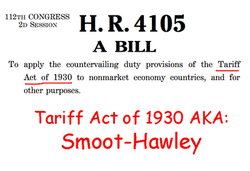 Like the Jefferson Embargo Act of 1803, HR4105 Illustrated the Results of Mixing Agriculture and Short-sighted Political Policy. Ultimately the Act Served To Force Importers of Us Ag Goods to Seek Other Markets Serving to Prolong the Depression's Effects on American Farmers and Consumers
Collapse, Failures, and Looking Toward the New Deal
Between 1930 and 1932, amidst foreclosures, falling commodity prices, government ineptness, drought and a plethora of crises and disasters, farmers continually adjusted in the name of survival. Some were successful and many were not. The Hoover administration did little to help agriculture beyond following the same stale and unsuccessful tactics of the past. As wheat prices fell below $1per bushel in January, the Hoover administration contemplated the Smoot-Hawley Tariff and eventually signed off on the bill in June of 1930, triggering a wave of retailtory tariffs from trading partners throughout the world that both effected farmers at that time and created an opportunity for farmers throughout the world to have access to former customers of U.S. agricultural producers.(51) 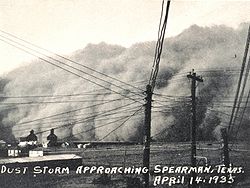
1932-36: Some Very Bad Years and Poor Decisions
In the years after World War I, the vast acreage available in the Great Plains provided the country with an opportunity to capitalize on the devastation of European agriculture caused by the war.Again, like the "Bonanza Farm Era" this produced conditions that encouraged mass production at the expense of sound cultural practices Because of this pressure and the money available, locally-based SES (Soil Erosion Service) administrators were subject to corruption and coercion, rendering enforcement of conservation practices weak at best. The effects of the Depression served to exacerbate problems of the already difficult and complex business of farming, and while environmental conditions began to line-up in favor of the “perfect storm,” government and big business had facilitated conditions that had fostered a modified “slash and burn system” policy in search of greater profits, new employment opportunities and control over the untamed West and to some extent, the economies of the “Old World.” With uncontrolled overgrazing already weakening vast tracts of grasslands, the introduction of the steel plow and its subsequent improvements made it possible to break, turn-over and cultivate the formidable root structure and top-growth of the native sod. Coupled with a cyclical drought period, conditions were ripe for agriculture/environmental disaster " the Dust Bowl" that ensued. By the time the drought broke, temporarily in 1936, over 100 million acres of prime plains grassland were destroyed and an estimated 500 thousand Americans became jobless and may of those homeless. (53)(54)(55) |
The New Deal and Agriculture New Deal was, and is still the most controversial and aggressive package of government (presidential) policy programs in the history of this country. From the outset, the New Deal gave the Executive branch unprecedented power and control over all aspects of the economy and consequently the daily lives of farmers. The Agricultural Adjustment Act was signed into law just weeks after Roosevelt took office and it immediately gave quasi-dictatorial powers to the Federal government in an effort to manipulate and pre-plan all controllable factors that affected the market and supply, done so in the interest of the country. The main crops affected were corn, wheat, cotton, rice, beans, peanuts, tobacco, and milk, but there was no sector of agriculture that was immune to government control. In its most basic and original form ( the original Act was overturned in 1936 and then re-written) the AAA worked by having farmers cut production by 30% (they were then reimbursed for their loss of product through a tax levied on both food and clothing industry). By creating an artificial balance between supply and demand, the government, in effect, raised the purchasing power of the farmer, which in turn and in theory, infused more dollars back into the manufacturing sector. After 1936, the function of the AAA and the USDA as its primary facilitator/enforcer expanded into the areas of soil conservation (in direct response to the Dust Bowl event(s), food storage/reserves and commodity-price fixing. While landowners were the main beneficiaries of these policies, sharecroppers and tenet farmers, the poorest farmers and mainstays of the Southern agricultural system of the day, not only suffered but often found themselves displaced as landlords took“their” acreage out of production to meet the requirements for receiving AAA subsidies. (52) |
Downturn, WW II and the Dawn of the Agricultural Class Structure
The original Agricultural Adjustment Act was declared unconstitutional in 1936 on the grounds that it was illegal to tax one group to pay another. The
Roosevelt administration quickly rewrote the legislation eliminating the processors’ levy and shifted the financing of the program to the general fund. It is accepted that there was a modest recovery from the depression in the early years of the Roosevelt administration (1933-1937) particularly for medium- to-large scale agriculture and related businesses.There is however, a little discussed period of downturn that resurfaced just after the start of 1937, known as ‘Roosevelt’s Depression.’ Though many of the actions that resulted from the AAA were positive, several additional acts that were implemented during the ‘Roosevelt Depression’ period, including the Resettlement Act and the Farm Security Agency, became disasters for the government. Though many of the actions that resulted from the AAA were positive, several additional acts that were implemented during the‘Roosevelt Depression’ period, including the Resettlement Act(RA) the Farm Security Agency(FSA) became disasters for the government. the highly socialist overtones of some of the actions that resulted from the RA (later to fall under the auspices of the FSA) were so controversial that they were challenged by the Supreme Court on several occasions including the “Franklin County et.al. vs. Tugwell,” which found that the RA/FSA had violated the Tenth Amendment in a number cases in which the federal government attempted to establish “Greenbelt communities and Soviet-style collective farms. “ The feedback and political ramifications of the RA/FSA, exacerbated by the downturn, marked yet another milestone in American agriculture as an institution as it further defined the hierarchy of the industry itself, identifying the real schism between the small farm and the medium-to- large, more industrial operations (ultimately coming down in favor of the latter).
As the country began to move toward war, it became clear that the federal government through the USDA, and supported by the Farm Bureau and the Grange, was going to eventually abandon its efforts at seeking equality among all farmers and concentrate on a larger more productive model for the future. Additionally, as the war effort ramped up, factory jobs became plentiful, which in turn, meant that the concern for the rural unemployed was no longer a factor. This turn of events provided the embattled administration a rationalization for distancing itself from the FSA (and eventually dissolving it in 1946) while saving face. Sociologists Jess Gilbert and Carolyn Howe, in a study of the era, evidence the fact that this shift marked the beginning of a government-induced defined class structure within the agricultural community. One of their key
observations includes, ‘. . . commercial farmers were able to beat back challenges from the agricultural underclasses and gain an enduring niche within the government.’
As the war effort gained momentum, the government began to shift its focus from control (at least temporarily) of agriculture to the facilitation of production
with a general tenor of a “hands-off” policy. Agricultural deferments were granted to farmers who produced essential crops (the interpretation of “essential” was very
liberal)The War Manpower Commission (Exec. Order 9139:1941), in terms of the agricultural sector, contained provisions that effectively left the government out of labor and wage mitigation between agribusiness and workers. Disturbingly, the order also gave the government the right to force laborers to either remain on farms, move to farms deemed important by the Commission, or face the threat of the draft; thus creating a modified slave labor class (paid but not free to move about or choose other employment). Abuse of these provisions was rampant and included such actions as forcing sharecroppers to ( illegally) sign contracts or face conscription, forcing
laborers who didn’t comply with the farm owners to be drafted, falsifying information to deceive laborers into believing that the growers represented the government , and complicity between growers and county agents in forcing laborers to accept low wages and long hours. The abuses continued until the end of the war and escalated to include less-than-subsistence wages for migrants and prisoners of war as well as the use of children and women in the fields. At war’s end, the average farm income
had risen and had in fact almost tripled due to the demands created by the war and the laissez faire type policies that were practiced at the beginning of the war. By 1947, adjustments and greater government control crept back into the industry and the die was cast, as American agriculture moved into its most productive phase ever.(56)(57)(58)(59)(60)
The original Agricultural Adjustment Act was declared unconstitutional in 1936 on the grounds that it was illegal to tax one group to pay another. The
Roosevelt administration quickly rewrote the legislation eliminating the processors’ levy and shifted the financing of the program to the general fund. It is accepted that there was a modest recovery from the depression in the early years of the Roosevelt administration (1933-1937) particularly for medium- to-large scale agriculture and related businesses.There is however, a little discussed period of downturn that resurfaced just after the start of 1937, known as ‘Roosevelt’s Depression.’ Though many of the actions that resulted from the AAA were positive, several additional acts that were implemented during the ‘Roosevelt Depression’ period, including the Resettlement Act and the Farm Security Agency, became disasters for the government. Though many of the actions that resulted from the AAA were positive, several additional acts that were implemented during the‘Roosevelt Depression’ period, including the Resettlement Act(RA) the Farm Security Agency(FSA) became disasters for the government. the highly socialist overtones of some of the actions that resulted from the RA (later to fall under the auspices of the FSA) were so controversial that they were challenged by the Supreme Court on several occasions including the “Franklin County et.al. vs. Tugwell,” which found that the RA/FSA had violated the Tenth Amendment in a number cases in which the federal government attempted to establish “Greenbelt communities and Soviet-style collective farms. “ The feedback and political ramifications of the RA/FSA, exacerbated by the downturn, marked yet another milestone in American agriculture as an institution as it further defined the hierarchy of the industry itself, identifying the real schism between the small farm and the medium-to- large, more industrial operations (ultimately coming down in favor of the latter).
As the country began to move toward war, it became clear that the federal government through the USDA, and supported by the Farm Bureau and the Grange, was going to eventually abandon its efforts at seeking equality among all farmers and concentrate on a larger more productive model for the future. Additionally, as the war effort ramped up, factory jobs became plentiful, which in turn, meant that the concern for the rural unemployed was no longer a factor. This turn of events provided the embattled administration a rationalization for distancing itself from the FSA (and eventually dissolving it in 1946) while saving face. Sociologists Jess Gilbert and Carolyn Howe, in a study of the era, evidence the fact that this shift marked the beginning of a government-induced defined class structure within the agricultural community. One of their key
observations includes, ‘. . . commercial farmers were able to beat back challenges from the agricultural underclasses and gain an enduring niche within the government.’
As the war effort gained momentum, the government began to shift its focus from control (at least temporarily) of agriculture to the facilitation of production
with a general tenor of a “hands-off” policy. Agricultural deferments were granted to farmers who produced essential crops (the interpretation of “essential” was very
liberal)The War Manpower Commission (Exec. Order 9139:1941), in terms of the agricultural sector, contained provisions that effectively left the government out of labor and wage mitigation between agribusiness and workers. Disturbingly, the order also gave the government the right to force laborers to either remain on farms, move to farms deemed important by the Commission, or face the threat of the draft; thus creating a modified slave labor class (paid but not free to move about or choose other employment). Abuse of these provisions was rampant and included such actions as forcing sharecroppers to ( illegally) sign contracts or face conscription, forcing
laborers who didn’t comply with the farm owners to be drafted, falsifying information to deceive laborers into believing that the growers represented the government , and complicity between growers and county agents in forcing laborers to accept low wages and long hours. The abuses continued until the end of the war and escalated to include less-than-subsistence wages for migrants and prisoners of war as well as the use of children and women in the fields. At war’s end, the average farm income
had risen and had in fact almost tripled due to the demands created by the war and the laissez faire type policies that were practiced at the beginning of the war. By 1947, adjustments and greater government control crept back into the industry and the die was cast, as American agriculture moved into its most productive phase ever.(56)(57)(58)(59)(60)
The Symbiosis Between the policies of the New Deal and the Science and Technology of the War Effort Created the Modern Era of Farming. . . The Era That We Largely Live Under Today . . . the Era From Which Many Small Farmers Struggle to Escape As They Move Into the New Millennium.
Part Three: From WW II to the New Millenium

Beating Swords Into Ploughshares.
The end of World War II marked the beginning of an era in which American agriculture reached “adulthood.’’ Though farming retained its aura of family tradition and as the epitome of the Christian work ethic, in reality it had evolved into an industry that had come of age in the world as a big business; now, mechanized, scientifically-based, dependent on financial institutions, and often a ward of the state and as such, subject to the whims of politics and politicians. The New Deal legislation originally enacted in 1930-40’s had firmly established the power(and gargantuan budget) of the USDA and set a precedent so iron-clad that the basic tenets and modus operandi of the government and agriculture policy remained virtually unchanged into the new millenium, despite numerous attempts at reform and revision. With the passing of each new piece of legislation came a greater capitulation to agri-business, with diminishing concern for the small and family-based farm beyond political and nostalgic rhetoric. To understand the present state of agriculture, it is important to look at the rapid advancements in technology, public and private financing, and government policy since the end of World War II in the context of an interactive set of components that, though dependent on each other, often are in conflict, vying for the money and power of an enormous but still, finite market.
|
The Science of the Farm
NPK With the exception of the relatively new (derived from classic techniques) organic/sustainable farm model, the use of chemicals, including fertilizers, pesticides, herbicides, and hormones, is a staple of the modern farm, regardless of size. With the fall of the diverse farm model in favor of crop specialization, non-manure based farming requires artificial sources of macro-nutrients including nitrogen, phosphorous, potassium, calcium, sulfur and magnesium. The process of creating synthetic nitrogen was developed and perfected by German chemist Fritz Haber (originally for the production of gas warfare-WW I). This technology was adapted by American scientists in the 1940’s specifically for the manufacture of high explosives for the war effort. These same facilities, post-war, were converted to the production of commercial fertilizer in the form of ammonium nitrate, providing farmers with a cheap and abundant supply of the material. On the recommendation of the land grant colleges and the USDA, synthetic nitrogen has become a staple of farming with wheat (utilizing 17% of world’s total N supply) and corn (utilizing 45% of the U.S., N supply) production the biggest consumers of the product.There is no denying that agriculture and mankind has benefitted from the increased food production, enormously aided by by synthetically- produced nitrogen; however, in the flurry to promote methods for its use, developed and encouraged by agricultural policy makers, there has been (until recently) little attention paid to the negative environmental consequences that accompany these practices (61)(62) |
2-4-D DDT and Beyond
By 1945, the development and availability of a range of pesticides (insecticides, fungicides and herbicides) that included DDT and 2-4-D enabled farmers to utilize new chemical tools to increase production and reduce labor. The USDA, land-grant colleges, and with few exceptions, farmers, big and small, embraced these new materials, so totally focused on their benefits that there was little thought given to any potential dangerous side effects.(63)(64) HORMONES & GENETIC ENGINEERING As chemistry and science continued to play a role in the “advancement” of agriculture, the field of genetics entered the picture. One of the most important breakthroughs in the field of “agro-genetics,” (that is the use of genetic engineering to produce altered species of plants and animals... as well as hormones and growth regulators for agriculture). Innovations such as Roundup-Resistant corn, rBGH hormones for increased milk production, and pest resistant plants like boll- weevil resistant cotton though controversial, has changed the face of agriculture permanently. (65)(66)(67)(68) |
Finance and Debt Load: The Origins and Tragedy of Welfare Farming
Since the early days of the Republic, all farmers, except the extremely wealthy, relied on some type of credit system to purchase land, to provide “seed money”in the spring, and as a means to fill the cash-flow gap prior to fall harvest. Farming, like every other American business is not immune to “boom and bust” cycles and as farming moved toward commercialization, the need (and often the “desire”) for credit multiplied geometrically. While private credit sources existed prior to the turn of the century (1900), including the usury-ridden, crop-lien system imposed upon sharecroppers and small farmers (generally in the South in the latter part of the 19th century), legislation and initiatives begun in 1902, and carried through the New Deal set the precedent for a massive credit-fueled partnership between banks, the federal and state governments, and farmers. The use of credit by farmers increased exponentially after WWII in response to both the need to expand and modernize operations, and government encouragement to do so.The use of credit by farmers increased exponentially after WWII in response to both the need to expand and modernize operations, and government encouragement to do so. In the latter half of WWII and during the Korean War, the previous allotment system was suspended as farmers were encouraged to produce at a high level to both profit from and compensate for the disruption in the world food supply caused by the war(s). With the technological advancements of the previous decades including the gasoline tractor and herbicides, pesticides, and cheap chemical fertilizers, farmers were able to produce more and
work more acreage than ever before, by supplanting expensive hand labor with the product of fossil fuels in various forms. Beginning in 1951, the gap between input and output widened exponentially. Charting the input/output ratio for the period between 1950 and 1973, reveals that input remained flat, even declining slightly between 1957 and 1964, while production (output) grew 60%. In terms of crop production vs. farmed acres during the same period, the gap was even greater, as the amount of acres farmed fell and the yields per acre increased. Large capital and equipment investments were required to achieve these results, and as such, farmers were forced to obtain credit to make the necessary upgrades to remain competitive. The cost of a new combine ($7K) in 1965 might well exceed the yearly profit (often the same as family income which did not exceed $4-5k) of a small to medium farm.The debt to asset ratio for medium to large farms (sales over $20K) over the period from 1950-1974, grew at a very unhealthy rate of approximately 2.4% per year, with the largest of farms pledging almost 25% of their total assets to debt and debt service.
Upon the election of Richard Nixon in 1972, farm policy (in regards to production controls ) literally broke open under the direction of the Secretary of Agriculture Earl Butz. Upon inking a deal with the USSR for wheat and corn specifically, previous restraints on production were lifted and farmers ‘bought into’ the new Butz policy of “get bigger or get out. . .” This new policy required a new infusion of cash to purchase land and new equipment. Banks, backed by the various federal farm and rural lending vehicles available to them, were eager, beyond reason, to loan money to those who wished to fulfill the Butz policy . . . with an eye to cashing in on the new- found agricultural bonanza. As a forbearer of the financial crises that occurred in the mortgage “meltdown” of the 2008, financial institutions went beyond conventional, ethical and financial standards to find “creative” solutions to leverage “paper assets” of farmers in order to qualify them for larger and larger lines of credit to expand operations. While political lip-service was paid to addressing the increasing farm debt crisies through every adminstration to the present, these policies have remained largely intact to this day, in many shapes and forms all exacerbated by government subsidies and reluctance to let certain market forces run their course. (69)(70)(71)(72)(73)(74)(75)
Since the early days of the Republic, all farmers, except the extremely wealthy, relied on some type of credit system to purchase land, to provide “seed money”in the spring, and as a means to fill the cash-flow gap prior to fall harvest. Farming, like every other American business is not immune to “boom and bust” cycles and as farming moved toward commercialization, the need (and often the “desire”) for credit multiplied geometrically. While private credit sources existed prior to the turn of the century (1900), including the usury-ridden, crop-lien system imposed upon sharecroppers and small farmers (generally in the South in the latter part of the 19th century), legislation and initiatives begun in 1902, and carried through the New Deal set the precedent for a massive credit-fueled partnership between banks, the federal and state governments, and farmers. The use of credit by farmers increased exponentially after WWII in response to both the need to expand and modernize operations, and government encouragement to do so.The use of credit by farmers increased exponentially after WWII in response to both the need to expand and modernize operations, and government encouragement to do so. In the latter half of WWII and during the Korean War, the previous allotment system was suspended as farmers were encouraged to produce at a high level to both profit from and compensate for the disruption in the world food supply caused by the war(s). With the technological advancements of the previous decades including the gasoline tractor and herbicides, pesticides, and cheap chemical fertilizers, farmers were able to produce more and
work more acreage than ever before, by supplanting expensive hand labor with the product of fossil fuels in various forms. Beginning in 1951, the gap between input and output widened exponentially. Charting the input/output ratio for the period between 1950 and 1973, reveals that input remained flat, even declining slightly between 1957 and 1964, while production (output) grew 60%. In terms of crop production vs. farmed acres during the same period, the gap was even greater, as the amount of acres farmed fell and the yields per acre increased. Large capital and equipment investments were required to achieve these results, and as such, farmers were forced to obtain credit to make the necessary upgrades to remain competitive. The cost of a new combine ($7K) in 1965 might well exceed the yearly profit (often the same as family income which did not exceed $4-5k) of a small to medium farm.The debt to asset ratio for medium to large farms (sales over $20K) over the period from 1950-1974, grew at a very unhealthy rate of approximately 2.4% per year, with the largest of farms pledging almost 25% of their total assets to debt and debt service.
Upon the election of Richard Nixon in 1972, farm policy (in regards to production controls ) literally broke open under the direction of the Secretary of Agriculture Earl Butz. Upon inking a deal with the USSR for wheat and corn specifically, previous restraints on production were lifted and farmers ‘bought into’ the new Butz policy of “get bigger or get out. . .” This new policy required a new infusion of cash to purchase land and new equipment. Banks, backed by the various federal farm and rural lending vehicles available to them, were eager, beyond reason, to loan money to those who wished to fulfill the Butz policy . . . with an eye to cashing in on the new- found agricultural bonanza. As a forbearer of the financial crises that occurred in the mortgage “meltdown” of the 2008, financial institutions went beyond conventional, ethical and financial standards to find “creative” solutions to leverage “paper assets” of farmers in order to qualify them for larger and larger lines of credit to expand operations. While political lip-service was paid to addressing the increasing farm debt crisies through every adminstration to the present, these policies have remained largely intact to this day, in many shapes and forms all exacerbated by government subsidies and reluctance to let certain market forces run their course. (69)(70)(71)(72)(73)(74)(75)
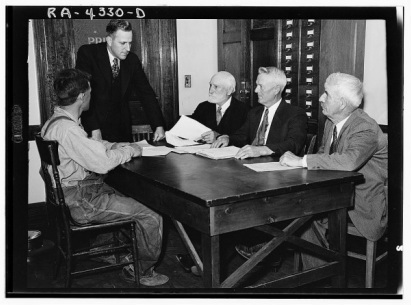 While Farm Credit and Debt Issues Came to a head in the 1980's. The Problems Associated with These Issues Have Been a Mainstay of American Agriculture Since the Wilson Administration.
Subsidized
Farming and the Solidification of the Agribusiness Model The loose and misguided credit policies of the Eisenhower through Carter administrations were not the only factors leading to the farm-crises era of the 1980’s. Within every farm policy were elements of subsidies, price supports, and complicated quota systems that constantly and artificially manipulated the economics of farming. Essentially, the laws of supply and demand that serve to wean businesses from non-profitable practices were never given a fair chance to work and subsidies have often provided a disincentive to farmers to look at their ‘‘businesses as businesses.” These economic manipulations emerged in a dizzying array of forms that included: Allotments: acreage allowed for growing of specific commodities to control supply. Compliance results in subsidies in various forms: · Diverted, set-aside or conservation acreage: land moved out of production and used for conservation or non-controlled produce subsidized. · Price supports: government support of commodity prices to assure these prices did not fall below a predetermined level. · Price support loans: loans provided to farmers on stored commodities. Depending on the program, storage fees were often at the expense of the government. In the short term, consumers and farmers benefited greatly as food was abundant and cheap, and farmers were guaranteed minimum prices for the commodities they produced (or didn’t produce). The hidden tax that all citizens paid in the deal was that these programs were funded with taxpayer dollars in the final analysis.Despite the government’s sophisticated efforts to control production, surpluses have continued to be a problem. From 1950 to 1959, surpluses of regulated commodities averaged 7% per year and in the period between 1960 and 1962 averaged 10%. These surpluses continued unbridled through the early 1970s when there was a brief increase in world demand for grains and corn. Though in theory, actions designed to wean farmers from government supports and pare down the surpluses by the Reagan administration was likely a move in the right direction, in practice they were ill- planned and inequitable, reflecting greed, ulterior motives and a failure to place policy planning within recent historical context. While attacking subsidy programs, the Reagan administration continued to support programs that dedicated as much as 3% of the annual budget to subsidize non-productive or surplus- creating practices that only served to prolong the illusion that the farm model, born out of the New Deal could, at sometime, become a self-supporting and profitable business. (76)(77)(78) |
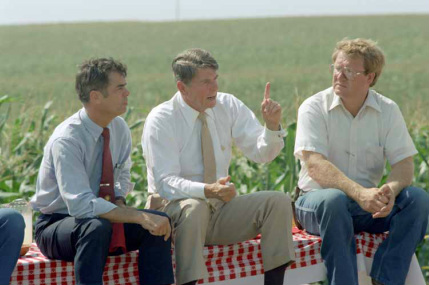 John Block Ag Secretary with President Reagan. Succumbing To Powerful Agribusiness and Food Lobbies The Reagan Adminstration Presided Over a Unprecedented Period of Farm Debt and Foreclosure.
The
New Deal Marching Into the 21st Century From Reagan to Obama, agricultural reform has been a campaign issue and the subject of the rhetoric of reform, but the essential elements that were born out of the post WW I farm policy, and later the New Deal, continue to this day.When Reagan came into office in 1980, he had pledged to reform farm policy, with the centerpiece of this change being the end of the wasteful and corrupt farm-support and subsidy system. The Reagan administration calculated that this would be a keystone in their deficit reduction strategy; so much so, that they included items reducing dairy supports, Food Stamps, commodity price supports and delaying disaster relief loans for farmers in three Omnibus Budget Reconciliation acts (P.L. 97-35:1981, P.L. 97-235:1982, P.L. 98-270:1983) within the first four years of his presidency. By the end of 1983, farm supports had risen to a record $21 billion, an increase of $17.5 billion over the previous (Carter) administration.Within the span of three years, the Department of Agriculture under Secretary John Block had succumbed to the same powerful farm lobby and the juggernaut of the USDA bureaucracy that had “tamed” and eventually controlled his predecessors. In this illustration of political irony and reality, the Reagan administration, in the midst of a recession, raised farm subsidies and entitlements to levels not seen since the New Deal. In 1985, Congress passed the Food Security Act, which, on paper, served to begin the process of reducing government support of agriculture. On close examination of the bill, it is evident that in essence, it was legislation fraught with loopholes, and with enforcement and interpretation clauses so open to the discretion of the Secretary of Agriculture that the same influences that caused previous price increases and mismanagement at the expense of the taxpayer could easily reemerge. This crucial piece of legislation in the end did more to hurt farmers and consumers than possibly any other since the Carter Grain Embargo Act of 1980. Among its many problems were:· Averaged-out, subsidies still amounted to $80k per full-time farmer ( not distributed equitably among all farmers) The act of pulling often marginalized acreage from production was institutionalized and paid for by the federal government. · Farmland prices increased. ( the equivalent of 60 million acres was taken out of production in 1990 alone) · The essential and sound cultural practices of crop rotation were severely limited, again subsidized by the federal government. · The actual USDA budget continued to grow (increasing 78% over the period 1980-1986 according to the CBO) · The farm economies of allied Third World countries were continually hurt because of subsidies and supports to both sugar and cotton; two of the least important crops in terms of our domestic production and number of farms. (79)(80)(81) |
Highlights in Farm Legislation and It Effects 1988-2008
George H. Bush farm policy: On the domestic front, the Food, Agriculture, Conservation and Trade Act of 1990 was the basic policy
format for the USDA during this administration. Like the 1985 version, this Act gave tremendous discretion to the Secretary of Agriculture on how and when provisions and cuts would be applied. Consequently, the interests of agribusiness/large scale-agriculture triumphed over reform and were protected from the realities of the free market, allowing surpluses to build at the expense of taxpayers. (82)
December 8, 1993 President Clinton signed NAFTA into law. Initially, this agreement became an important element in reducing surplus and
increasing commodity exports for producers of corn, beef, beans, rice and apples. The USTR (United States Trade Representative) tracked a 7% growth in U.S. agricultural exports to Canada and Mexico over its first 15 years. The debate over the real benefits of NAFTA (if any) raises many questions pro and con. While overall trade between the participants tripled, the price paid by the consumer, blue collar worker, and small business in terms of job loss and small farm loss (particularly in Mexico) ) has been called into question. In tracking inflation-adjusted income from 1993- 2005 of full-time small farms, a time that should have seen growth through increased exports, USDA figures show a decline in net farm income of 13% and a doubling of agricultural commodity imports. (83)(84)
The Federal Agriculture Improvement and Reform Act of 1996 (FAIR). The bill preserves the non-recourse loans with heritage back to the New Deal Agricultural Adjustment Act allowing farmers to store surpluses and speculate on commodities at taxpayer expense. This allowed farmers to default on loans and only risk the very commodity/crop they used as collateral, with no further ramifications or penalties. Many saw this as a corporate takeover because it gave an unfair competitive advantage to the specialized and efficient large corporate farms. Unlike previous support and subsidy conditions, farmers were not required to have crop insurance to participate, however they had to waive their
right to emergency crop loss assistance in the case of the loss of any uninsured crop.This exemption was tempting to smaller farmers who needed to squeeze every penny from their operations to approach profitability. Critics argued that this amounted to a further weakening of the small farmer foreseeing a potential death blow to a marginal operation in the event of a disastrous crop failure or loss. As predicted by critics market forces began to work as huge surpluses threatened to take down the entire industry. By the end of 2002, the total of expenditures for the FAIR Act and subsequent emergency spending acts totaled, at minimum, $118 billion over the seven year lifespan; an astounding $71 billion over the CBO projected cost of $47 billion for the period. [ Ironically, the failures of this act validated the fact that when heavily subsidized, commodity farm models do not continue to work. This is best illustrated by the fact that non-subsidized sectors, such as fruit, vegetable and nursery/greenhouse-growers saw an increase in revenue of $1.2 billion in 2000. (85)(86)(87)
“Farm Security and Rural Investment Act of 2002”.signed into law by President Bush in May 2002. This massive bill was budgeted at $170 billion over 10 years with $51 billion in subsidies. In short, it was merely a continuation of New Deal-type market manipulations. It further opened the chasm between agribusiness and small farming at both the taxpayer’s and small farmers' expense. In the guise of energy conservation and sustainability, funding for research and development, as well as production and related issues involving ethanol, was
provided. The ethanol subsidy in essence amounted to yet another hidden subsidy for the large corn producers and processors, which was, on average, a 54 cents per gallon stipend. This was another case in which the government made a commodity more valuable than its market price, completely contrary to the original intent of both this and the 1996 bill. Michael Pollan summed up the underlying problem and the known and unstated truth with the 2002 bill and all its modern predecessors, “ . . . that the $300 billion plus bill represents the exact price of buying off all the critics of the bill plus the cost of maintaining the status quo.” (88)(89)(90)(91)(92)(93)(94)
Food, Conservation, and Energy Act of 2008 enacted May 22, 2008. Surviving two vetoes from the President Bush, this legislation, while certainly preserving much of the status quo, is significant for the trending it indicates. While components of sustainable and alternative methodology had been present in previous legislation, this bill takes a broader view of the role of this sector (which is largely the realm of small farmers) to a higher level including a large number of provisions that favor the small farmer like never before. Some of the most significant programs that are included and currently in force (the 2012 Farm Bill is stalled in the House of Representitives having already passed in the Senate) are:
Integrated Organic and Water Program . National Organic Program . Organic Certification Cost Share Program .
Organic Connversion Program . Organic Agriculture Research and Extension Initiative . Organic Agriculture Research and Extension Initiative
Small Farm Program . Farmers Market Nutrition Program . Beginning Farmer and Rancher Programs · Farmer’s Market Promotion Program
The irony of the entire farm policy in this context is that each administration continues to use the myth and romanticism of the family farm to rationalize government support that by-in-large benefits (by percentages) the smallest group, which consists of the very large farmer and agribusiness corporations. (These entities, in turn, have the acumen and resources to maximize every micro-percentage of government subsidy to the advantage of their bottom line and their stock holders.) We now sit at point in history in which the very existence of the institution of the American small farm faces extinction.
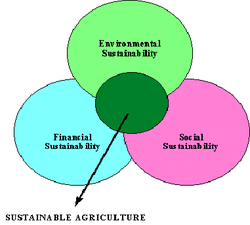
Hope and Change for the Future
Grass Roots Indications of a Paradigm
Shift.
Like many “revolutions,”changes in agriculture are measured and deliberate, and often come from the “bottom up.” During the post- WWII period, many small and family farmers “bought into” the USDA/land grant college/agribusiness philosophies principally in regards to the use of chemicals and petroleum based agriculture. In the rush to become modern and in reality, to stay competitive, time-tested and sound cultural practices that were more in tune with natural cycles were largely abandoned. This was the status quo through the turn of the century (21st) when an amalgam of factors began to coalesce into a new perspective on farming and agriculture in general, loosely termed “sustainable agriculture.”
These factors included: ·
-Greater general awareness of the importance of the environment by both producers and consumers.
·
-Acceptance of the general principles as confirmed by science, down to a molecular level, of the organic farming methodology: One important principle that came out of the now-burgeoning aquaculture industry was that, in a closed system, optimizing of yield is exactly linked to the harvest-replacement ratio and as such, if this ratio is in balance, harvesting can continue indefinitely.
-The resurgence of the family farm, small farm, hobby farm, and retirement farm: This movement has brought a new and often unconventional perspective to agriculture that includes the re-examination of traditional farm techniques and their viability. This new farm model consists of highly-informed and educated practitioners who often have the “luxury” of attempting “new” methods as their total income is not derived solely from the farm.
·
- Acknowledgement by the USDA and more importantly, the extension services of the land grant colleges: Institutions such as Cornell University and Ohio State University, (long bastions of big "agribusinessism") now recognize that “sustainable agriculture” and its accompanying methodologies are valid and important to the future of agriculture and in fact are based on sound scientific principles.
-The Cornell Cooperative Extension(CCE), began to recognize the small farm movement: The creation of programs such as “Small Farms Program,” (circa 2002) dedicated solely to the dissemination of technologies and related information applicable to the small and hobby farmer became a significant factor in the growth of the movement. In a bit of irony, as large-scale agriculture now turns away from the Extension Services [relying on inputs from corporate scientists and financiers] , organizations like the CCE now must, to a very large degree, rationalize their existence based on what they can offer to the small farm; the very entity that, at one time, they chose to relegate to a secondary status among their clientele.
·
-Economic considerations that have been exacerbated by the current recession and the high cost of food transportation: These conditions actually serve to promote locally grown food (limiting petroleum inputs) which is currently the sole bastion of the small independent farm that practices, in some part, “sustainable agriculture.”
·
-Cultural and societal awareness of the link between health, the environment, and support for local economies: This awareness translates into consumer willingness to spend more for agricultural products that are marketed locally and grown to certain standards: i.e. organically-grown, grass-fed, ethically-raised, and hormone-free.
(94)(95)(96)
Indicators
of Shift
Once considered a fringe element of agriculture, organic farming is big business for both large and small producers globally. Organic agriculture and its related industry, organic aquaculture are currently practiced on 13 million acres globally. In terms of U.S Dollars, at the current rate of growth ($5 billion per annum), the global sales
figures for organically produced products will be $61 billion in 2012.39 Of the greatest significance in terms of North American agriculture are the economic incentives for both small and corporate farming entities that organically produced products present. In terms of acres, North American organic agriculture makes up only .6% of the world total, but in terms of market dollars, the U.S., Mexican, and Canadian markets reap 45% of the entire market or projected revenues based on current growth rates of 18% per annum, or as much as $45.75 billion by the end of 2012. While altruism, environmental and social concerns may not be incentive enough for big corporate agriculture and agribusiness to rethink their petro-chemical methodology, the lure of big money has begun to make these entities take notice. Corporations such as Horizon
Organic, the largest purchaser of organic milk in the United States, is one company among a growing number of agribusinesses that has recognized the value
of a products produced in accord with the principles of sustainable agriculture.
Agriculture is, by its nature, a very scientific venture that requires research to grow and flourish. Farmers must be armed with a body of knowledge that ranges from entomology to agronomy to economics to biology and points beyond. Keeping this knowledge fresh, effective, and viable, simply put, requires money, and lots of it. One way to judge the legitimacy of a new or different technology is by the funding it receives from stable and “blue chip” sources that exhaustively research the causes they
support. In that vein, funding for sustainable and environmentally responsible agriculture has been on the increase over the course of the last decade as
evidenced by the results of a 2006 report published by the Headwaters Group of Philanthropic Services in regards to aid to sustainable agriculture and its
ancillary food systems research:
1. Government funding prior to 2003 for sustainable agriculture in the form of grants for research and related project was virtually non-existent.
2. From 1999 to 2002, foundation and non-government funding made up the bulk of sustainable agriculture funding and grants totaling approximately $55.2 million with an average yearly contribution of $13.8 million.
3. The period that includes 2003-2006 saw a dramatic increase in research funding and grants on the order of more than 400% overall, with government spending coming in at $89.7 million and private and foundation investing contributing approximately $124.8 million, making the total for the period $214.5 million overall or a average yearly investment of $71.5 from all sources (as opposed to the previous periods average of just under $14million).
Agriculture is big business in the United States, generating approximately $420 billion annually and with over $150 billion in exports. Though the federal government has been slow in recognizing and supporting new and emerging trends in the private sector, in relative terms, the USDA has reacted rapidly to the notion of sustainable agriculture, introducing a large number of programs that are geared to support sustainable agriculture in big ways. The most telling of these efforts comes in the form of publication entitled “Building Sustainable Farms, Ranches, and Communities” released in 2009. This publication is a solid endorsement for the coming of age of “sustainable agriculture,” and environmental improvement/conservation.
(98)(99)(100)(101)(102)(103)(104)
With the impending passage of the 2012 Farm Bill (Agriculture Reform, Food and Jobs Act of 2012) there are now indications that the face of American agriculture will diverge into two distinct and government sanctioned sectors : Agribusiness as one, and the other consisting of small to medium operations based largely on the Sustainable Agriculture Model. While to many this trending does not go far enough to stem the excesses of subsidized commodity farming (which run the gamut from environmental abuses to the waste of billions of dollars of taxpayer dollars), it does recognize the value, the profitability, and the ethical principles of a well run and well managed small farm as an important economic and quality-of-life component of the American fabric.(105)
move to next section: Women. On the Forefront of the New Farm Model
Grass Roots Indications of a Paradigm
Shift.
Like many “revolutions,”changes in agriculture are measured and deliberate, and often come from the “bottom up.” During the post- WWII period, many small and family farmers “bought into” the USDA/land grant college/agribusiness philosophies principally in regards to the use of chemicals and petroleum based agriculture. In the rush to become modern and in reality, to stay competitive, time-tested and sound cultural practices that were more in tune with natural cycles were largely abandoned. This was the status quo through the turn of the century (21st) when an amalgam of factors began to coalesce into a new perspective on farming and agriculture in general, loosely termed “sustainable agriculture.”
These factors included: ·
-Greater general awareness of the importance of the environment by both producers and consumers.
·
-Acceptance of the general principles as confirmed by science, down to a molecular level, of the organic farming methodology: One important principle that came out of the now-burgeoning aquaculture industry was that, in a closed system, optimizing of yield is exactly linked to the harvest-replacement ratio and as such, if this ratio is in balance, harvesting can continue indefinitely.
-The resurgence of the family farm, small farm, hobby farm, and retirement farm: This movement has brought a new and often unconventional perspective to agriculture that includes the re-examination of traditional farm techniques and their viability. This new farm model consists of highly-informed and educated practitioners who often have the “luxury” of attempting “new” methods as their total income is not derived solely from the farm.
·
- Acknowledgement by the USDA and more importantly, the extension services of the land grant colleges: Institutions such as Cornell University and Ohio State University, (long bastions of big "agribusinessism") now recognize that “sustainable agriculture” and its accompanying methodologies are valid and important to the future of agriculture and in fact are based on sound scientific principles.
-The Cornell Cooperative Extension(CCE), began to recognize the small farm movement: The creation of programs such as “Small Farms Program,” (circa 2002) dedicated solely to the dissemination of technologies and related information applicable to the small and hobby farmer became a significant factor in the growth of the movement. In a bit of irony, as large-scale agriculture now turns away from the Extension Services [relying on inputs from corporate scientists and financiers] , organizations like the CCE now must, to a very large degree, rationalize their existence based on what they can offer to the small farm; the very entity that, at one time, they chose to relegate to a secondary status among their clientele.
·
-Economic considerations that have been exacerbated by the current recession and the high cost of food transportation: These conditions actually serve to promote locally grown food (limiting petroleum inputs) which is currently the sole bastion of the small independent farm that practices, in some part, “sustainable agriculture.”
·
-Cultural and societal awareness of the link between health, the environment, and support for local economies: This awareness translates into consumer willingness to spend more for agricultural products that are marketed locally and grown to certain standards: i.e. organically-grown, grass-fed, ethically-raised, and hormone-free.
(94)(95)(96)
Indicators
of Shift
Once considered a fringe element of agriculture, organic farming is big business for both large and small producers globally. Organic agriculture and its related industry, organic aquaculture are currently practiced on 13 million acres globally. In terms of U.S Dollars, at the current rate of growth ($5 billion per annum), the global sales
figures for organically produced products will be $61 billion in 2012.39 Of the greatest significance in terms of North American agriculture are the economic incentives for both small and corporate farming entities that organically produced products present. In terms of acres, North American organic agriculture makes up only .6% of the world total, but in terms of market dollars, the U.S., Mexican, and Canadian markets reap 45% of the entire market or projected revenues based on current growth rates of 18% per annum, or as much as $45.75 billion by the end of 2012. While altruism, environmental and social concerns may not be incentive enough for big corporate agriculture and agribusiness to rethink their petro-chemical methodology, the lure of big money has begun to make these entities take notice. Corporations such as Horizon
Organic, the largest purchaser of organic milk in the United States, is one company among a growing number of agribusinesses that has recognized the value
of a products produced in accord with the principles of sustainable agriculture.
Agriculture is, by its nature, a very scientific venture that requires research to grow and flourish. Farmers must be armed with a body of knowledge that ranges from entomology to agronomy to economics to biology and points beyond. Keeping this knowledge fresh, effective, and viable, simply put, requires money, and lots of it. One way to judge the legitimacy of a new or different technology is by the funding it receives from stable and “blue chip” sources that exhaustively research the causes they
support. In that vein, funding for sustainable and environmentally responsible agriculture has been on the increase over the course of the last decade as
evidenced by the results of a 2006 report published by the Headwaters Group of Philanthropic Services in regards to aid to sustainable agriculture and its
ancillary food systems research:
1. Government funding prior to 2003 for sustainable agriculture in the form of grants for research and related project was virtually non-existent.
2. From 1999 to 2002, foundation and non-government funding made up the bulk of sustainable agriculture funding and grants totaling approximately $55.2 million with an average yearly contribution of $13.8 million.
3. The period that includes 2003-2006 saw a dramatic increase in research funding and grants on the order of more than 400% overall, with government spending coming in at $89.7 million and private and foundation investing contributing approximately $124.8 million, making the total for the period $214.5 million overall or a average yearly investment of $71.5 from all sources (as opposed to the previous periods average of just under $14million).
Agriculture is big business in the United States, generating approximately $420 billion annually and with over $150 billion in exports. Though the federal government has been slow in recognizing and supporting new and emerging trends in the private sector, in relative terms, the USDA has reacted rapidly to the notion of sustainable agriculture, introducing a large number of programs that are geared to support sustainable agriculture in big ways. The most telling of these efforts comes in the form of publication entitled “Building Sustainable Farms, Ranches, and Communities” released in 2009. This publication is a solid endorsement for the coming of age of “sustainable agriculture,” and environmental improvement/conservation.
(98)(99)(100)(101)(102)(103)(104)
With the impending passage of the 2012 Farm Bill (Agriculture Reform, Food and Jobs Act of 2012) there are now indications that the face of American agriculture will diverge into two distinct and government sanctioned sectors : Agribusiness as one, and the other consisting of small to medium operations based largely on the Sustainable Agriculture Model. While to many this trending does not go far enough to stem the excesses of subsidized commodity farming (which run the gamut from environmental abuses to the waste of billions of dollars of taxpayer dollars), it does recognize the value, the profitability, and the ethical principles of a well run and well managed small farm as an important economic and quality-of-life component of the American fabric.(105)
move to next section: Women. On the Forefront of the New Farm Model
